Timeline
1942
Jun Kaneko is born on July 13 in Nabebuta-cho, Atsuta-Ku, Nagoya, Japan. His father, Yutaka Kaneko, and his mother, Toyoko Ono Kaneko, are dentists. His brother, Shin, is born in 1943 and his sister, Sayaka, in 1947.

Toyoko Ono holding 3-month-old Jun Kaneko. Photo: Courtesy of Jun Kaneko.
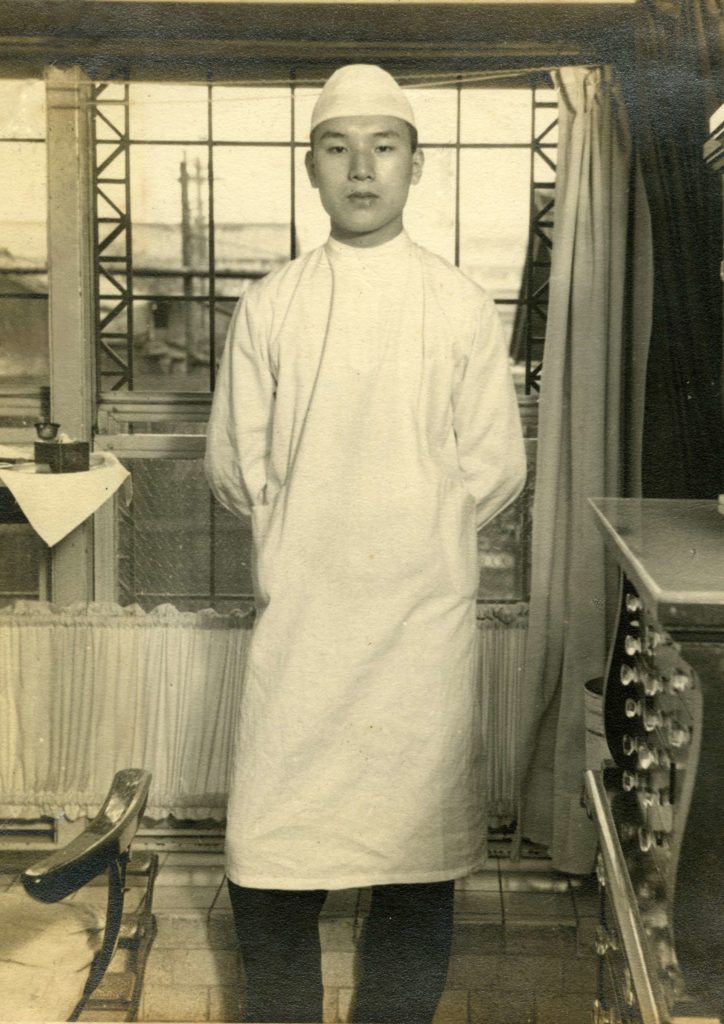
Yutaka Kaneko in his dental office. Photo: Courtesy of Jun Kaneko.
1945
The young Kaneko is sent to live with his grandparents in Chino, in the mountainous region of Nagano-ken, Japan, to escape the heavy bombing in Nagoya. His brother, too young to be apart from his mother and father, remains in Nagoya.

Jun Kaneko (L) and his brother Shin. Photo: Courtesy of Jun Kaneko.
1947
The Kaneko family moves from Nagoya City to Anzawa, a village in Nagano-ken, Japan. Jun Kaneko rejoins his family there.
1949
Kaneko starts elementary school in the mountains at age seven. The journey takes him an hour on foot, each way, and he often has to walk in snow and freezing temperatures.
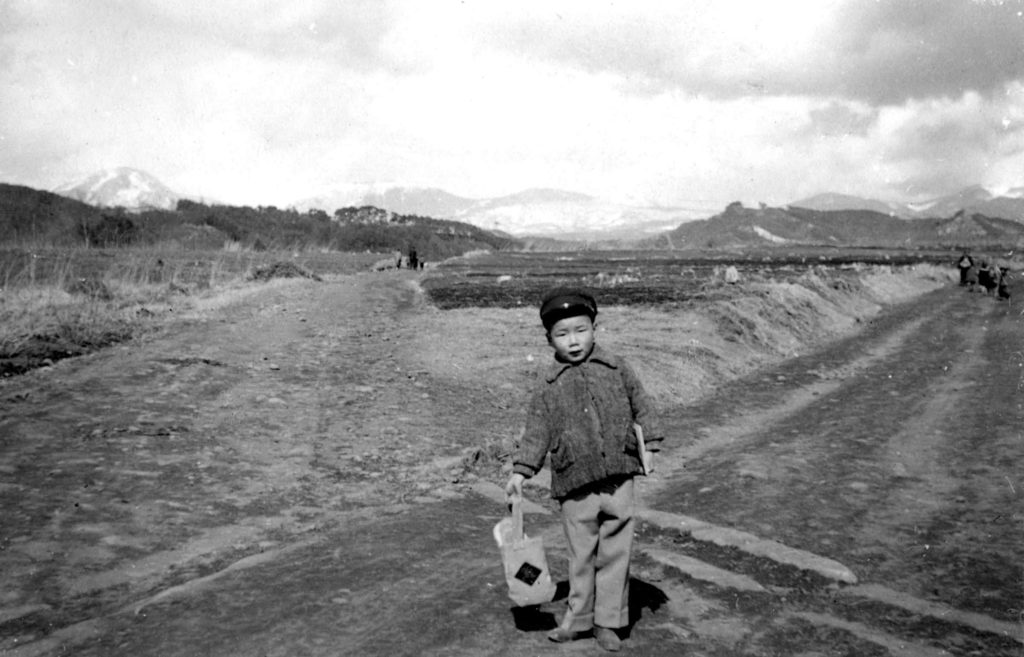
Jun Kaneko on his way to school in the mountains of Nagano-ken. Photo: Courtesy of Jun Kaneko.
1950
The Kaneko family moves back to Nagoya City, Japan. Kaneko’s mother and father open their dental practice, which remains in the same office until 2005, when Mrs. Kaneko retires at the age of 87.
Kaneko continues his schooling at Hakusui Elementary School in Minami-ku, Nagoya.
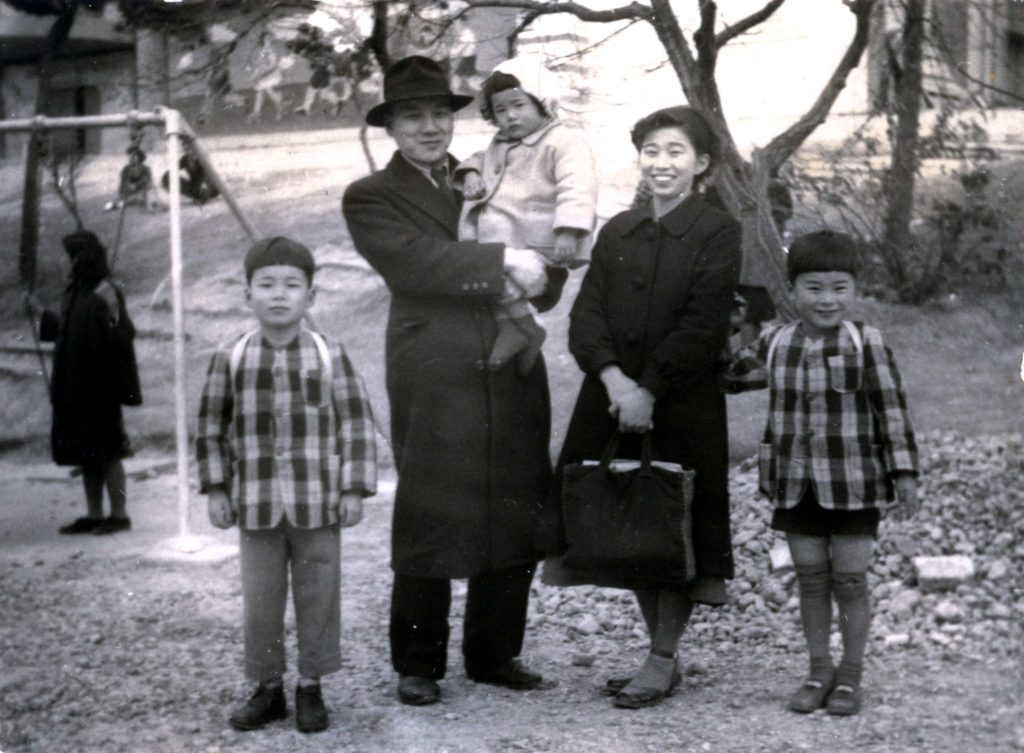
The Kaneko family in Nagoya, 1951. From left to right: Jun, Yutaka, Sayaka, Toyoko, Shin. Photo: Courtesy of Jun Kaneko.
1951
Kaneko transfers to Mitsurugi Elementary School in Mizuho-ku, Nagoya.
1955
Kaneko graduates from Mitsurugi Elementary School.
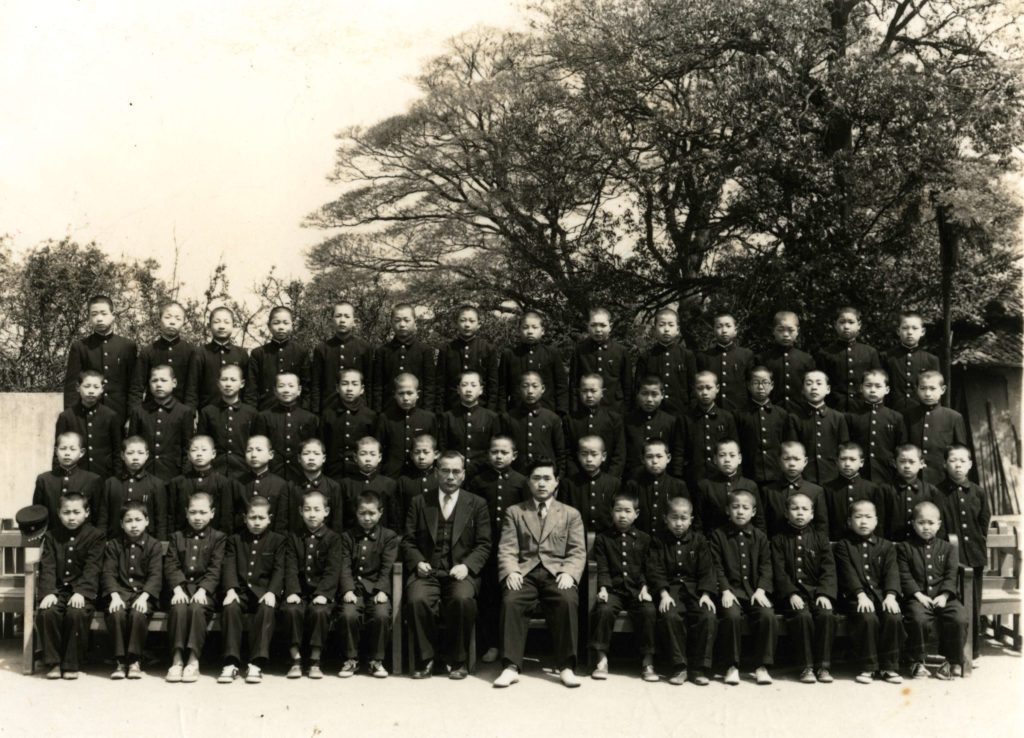
Class photo from Mitsurugi Elementary School. Photo: Courtesy of Jun Kaneko.
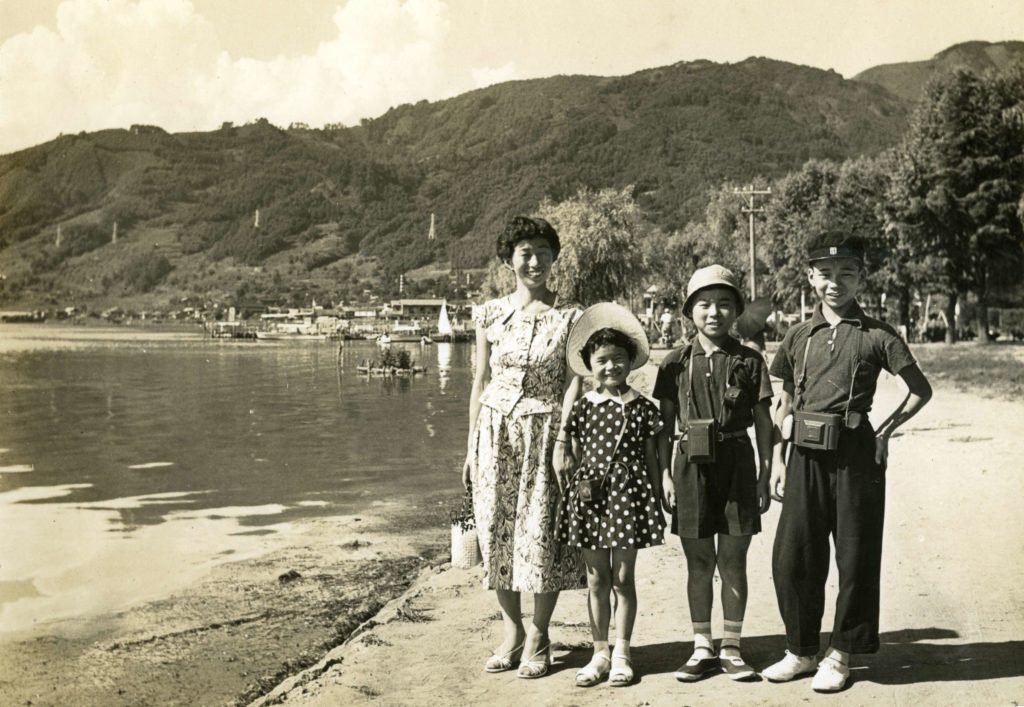
Jun Kaneko (right) with his mother and siblings on a beach trip. Photo: Courtesy of Jun Kaneko.
1958
Kaneko enters Nagoya Gakuin High School.
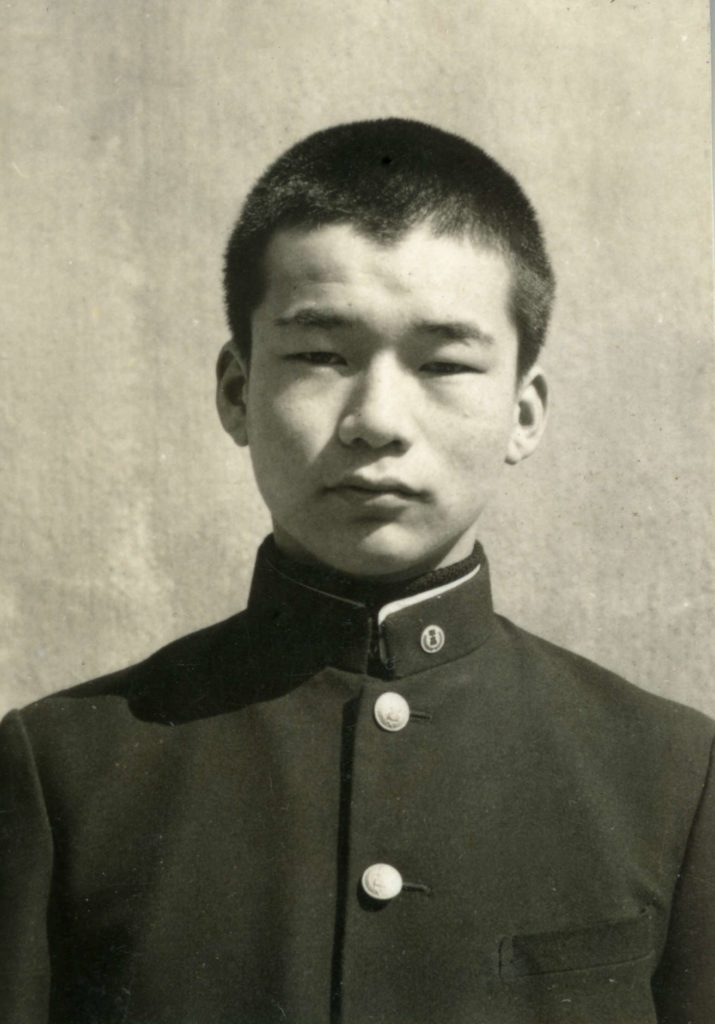
Jun Kaneko in his high school uniform. Photo: Courtesy of Jun Kaneko.
1960
Kaneko transfers to Meiwa High School to attend night classes, so that he can paint during the daytime.
1961
Kaneko starts to study painting under Satoshi Ogawa in Nagoya, working in his studio during the day and attending high school in the evening.
1962
Kaneko graduates from Meiwa High School. He paints full-time in Ogawa’s studio and in his own studio at home until departing for the US.
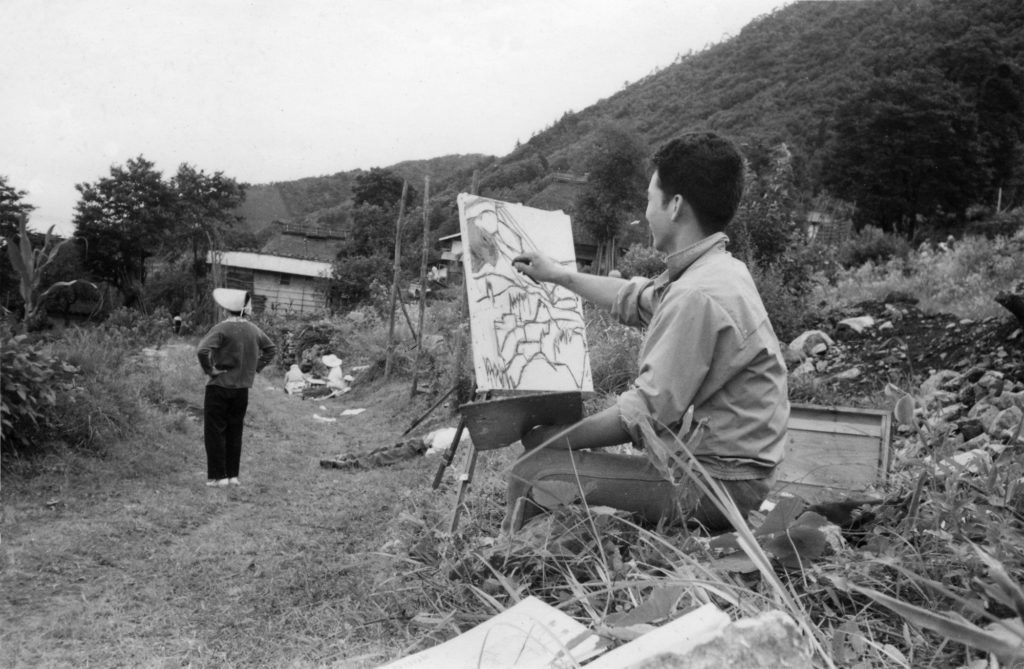
Jun Kaneko drawing en plein air in Japan. Photo: Courtesy of Jun Kaneko.
1963
August. Kaneko arrives in Los Angeles, California, to study painting. He meets Fred and Mary Marer on his first day and stays at their house at 537 North Kenmore Avenue for the remainder of the summer and then for another three months while they are traveling in Europe. Kaneko reorganizes and builds shelves for their extensive ceramics collection. This is his first encounter with contemporary ceramic work, particularly by Californian artists such as Voulkos, Mason, Takemoto, Price, Bengston, Frimkes, Melchart, and Rothman. In his practical undertaking, he becomes excited about, and interested in, working with clay. Fred and Mary Marer, on their return to Los Angeles, continue to invite Kaneko to spend time with them at their home and at their friends’ studios. They also visit museums and go to see movies two or three times a week. Their friendship proceeds like this until 1972, when he moves to New Hampshire to teach.
November. Kaneko works with clay for the first time at Scripps College. He is there for a week with Paul Soldner.
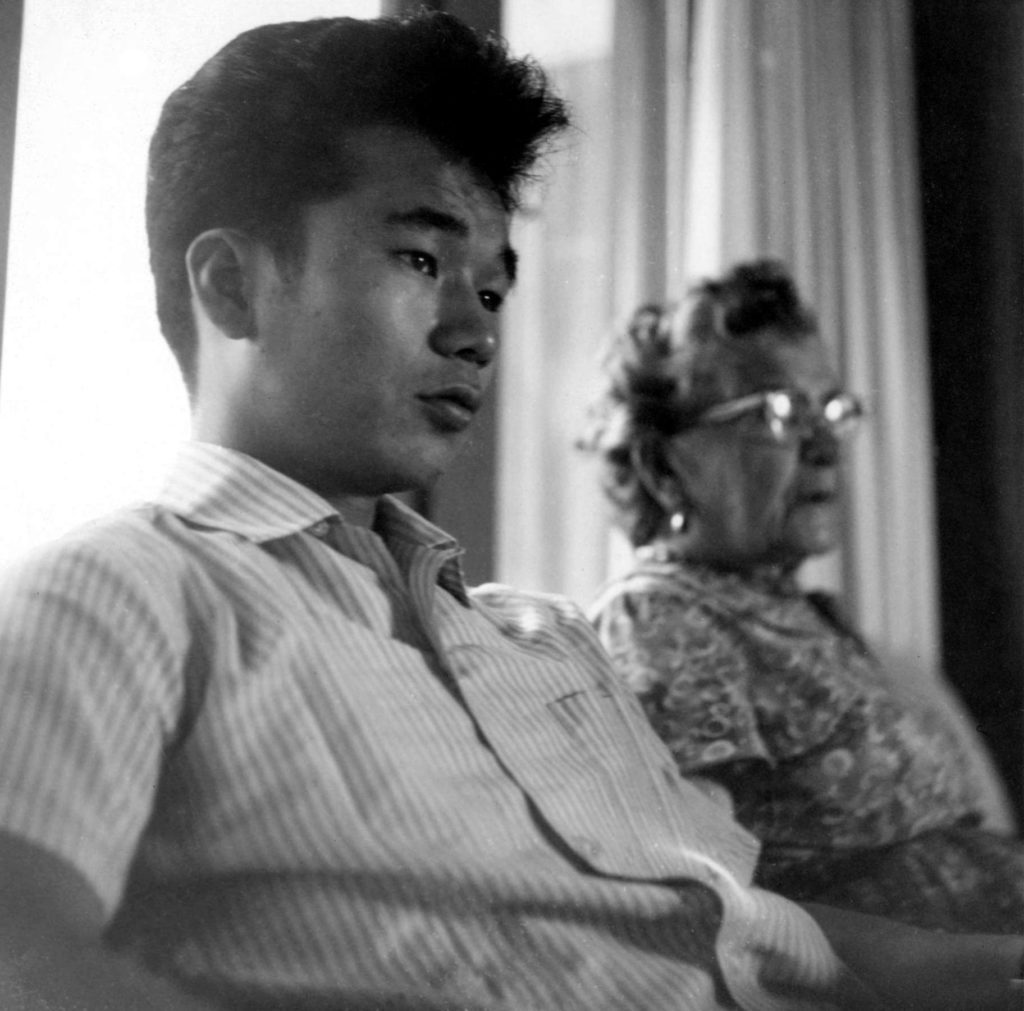
Jun Kaneko and Mary Marer (right). Photo: Courtesy of Jun Kaneko.
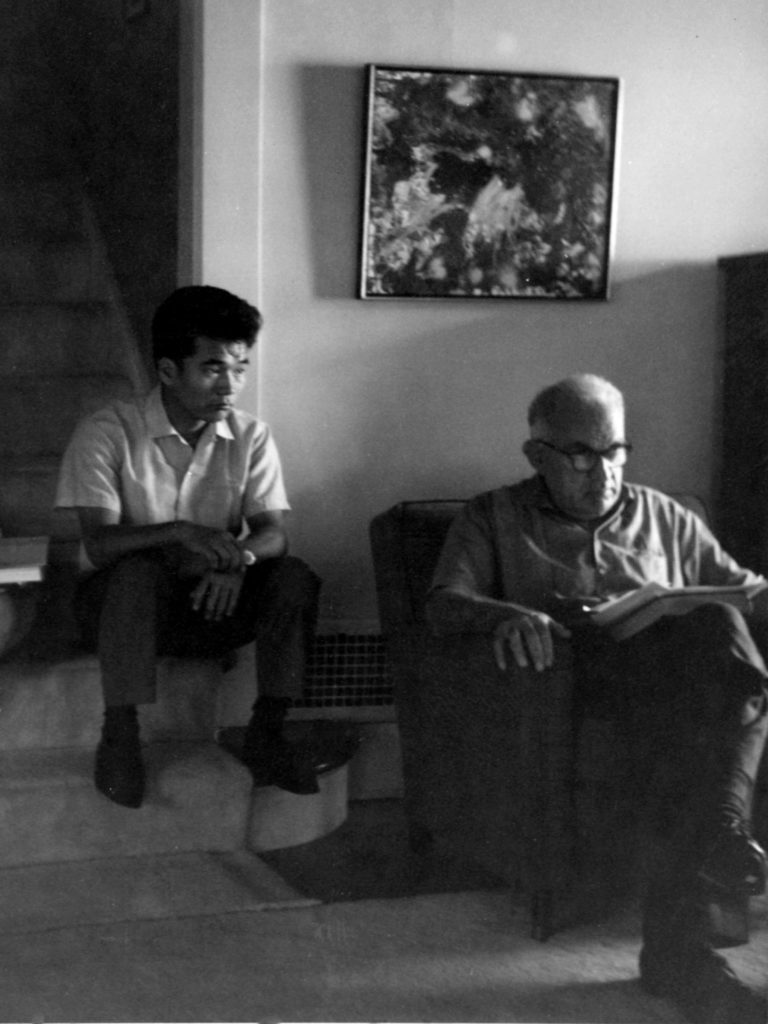
Jun Kaneko and Fred Marer (right). Photo: Courtesy of Jun Kaneko.
1964
Kaneko enrolls at the Chouinard Institute of Art in Los Angeles as a special student in painting, drawing, and printmaking. His limited knowledge of English makes communicating so slow that it forces him to change his lifestyle, attitude, and the way he makes art. How he deals with his work now is directly informed by this period.
Summer. Kaneko works at Jerry Rothmans’s studio and begins to work in ceramics. In the fall, he will return to his studies in painting and drawing at Chouinard.
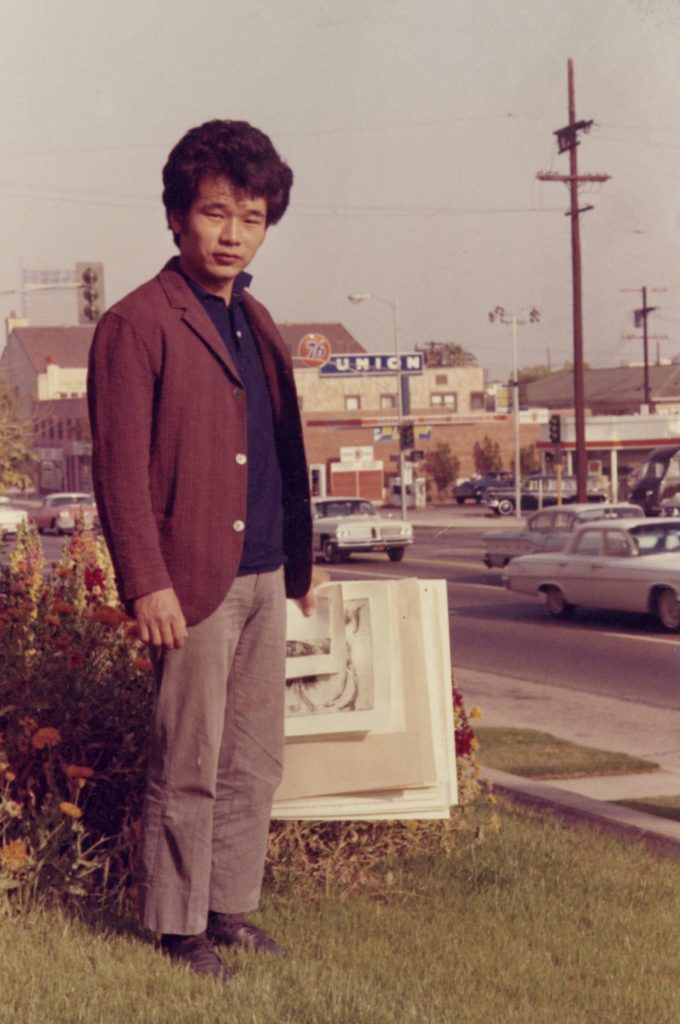
Jun Kaneko as an undergraduate student in Los Angeles. Photo: Courtesy of Jun Kaneko.
1965
Spring. Kaneko begins ceramic courses under Ralph Bacerra at Chouinard Institute of Art, Los Angeles, California.
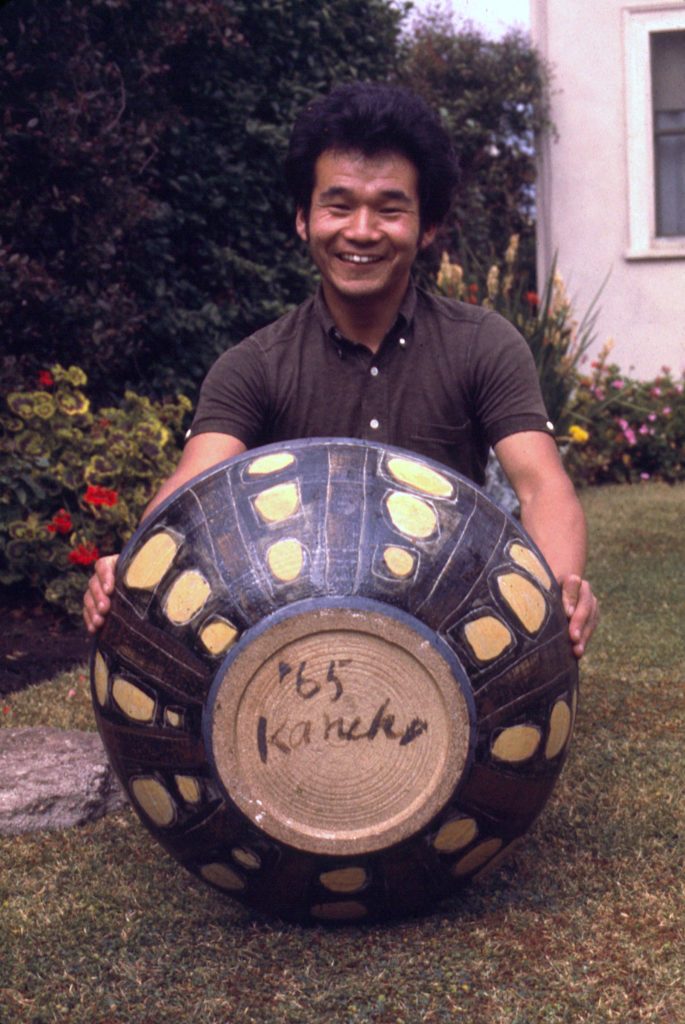
Jun Kaneko with one of his undergraduate ceramic works. Photo: Courtesy of Jun Kaneko.
1966
February. Kaneko quits Chouinard and helps Jerry Rothman for 18 months, building his studio on Towne Avenue in Los Angeles.
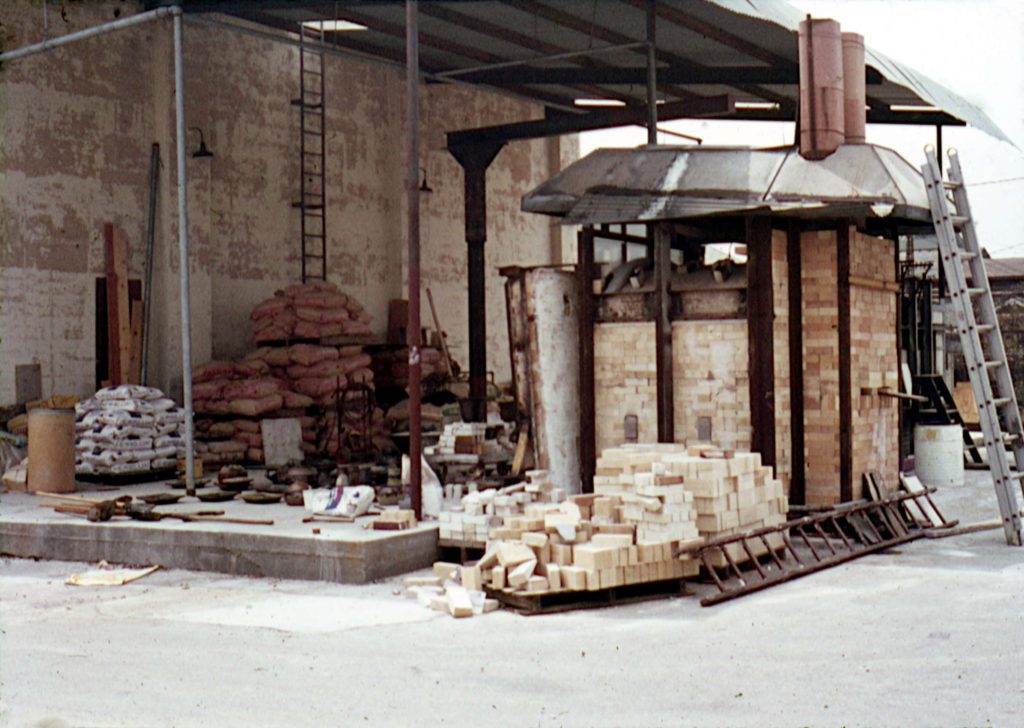
The first kiln Kaneko built at Jerry Rothman’s studio. Jun Kaneko.
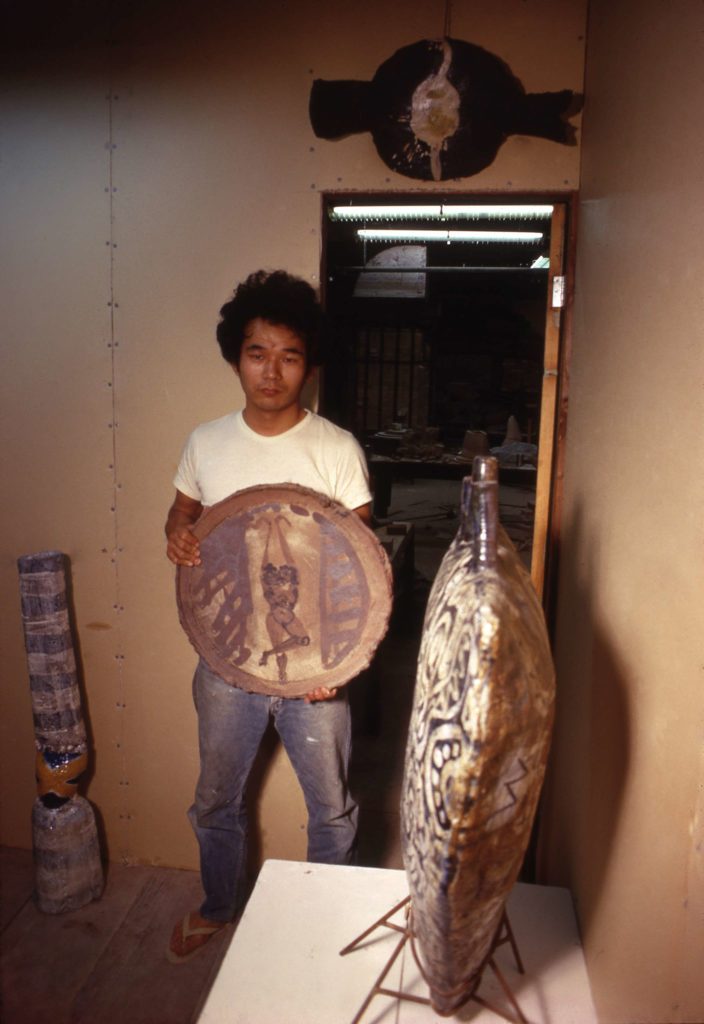
Jun Kaneko with his early ceramic works. Photo: Courtesy of Jun Kaneko.
1967
Summer. Kaneko receives an Archie Bray Foundation Grant and spends the summer at a three-month stipendiary residency in Helena, Montana.
Fall. He studies under Peter Voulkos at the University of California at Berkeley.
1968
Spring. Kaneko builds his own studio in Temple City, California.
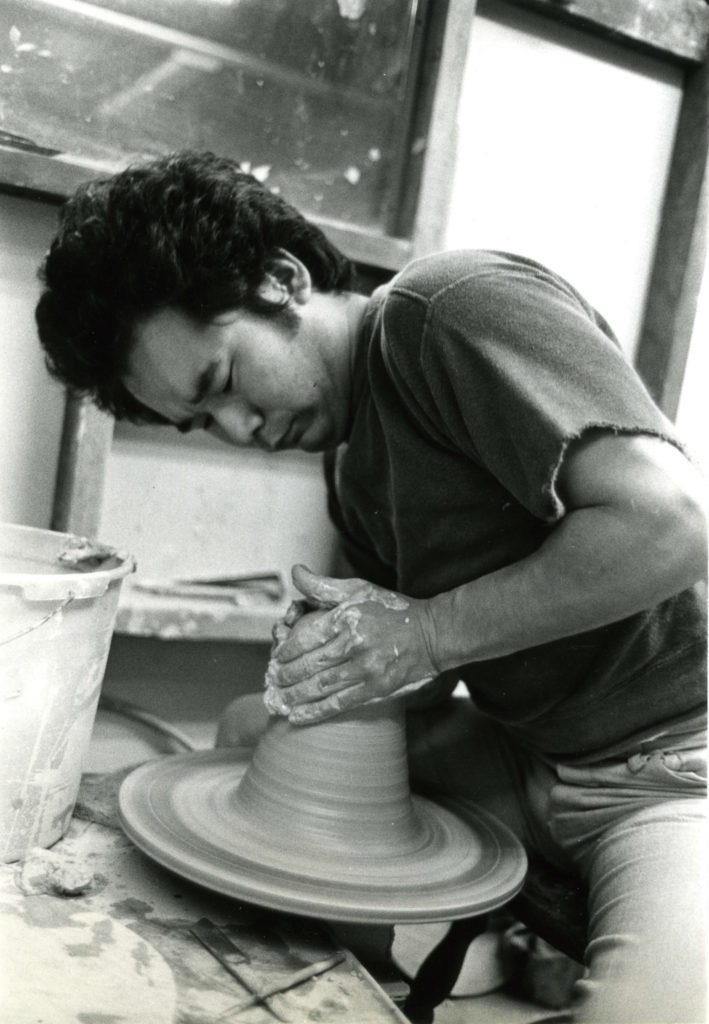
Jun Kaneko throwing a form on a pottery wheel,1968.
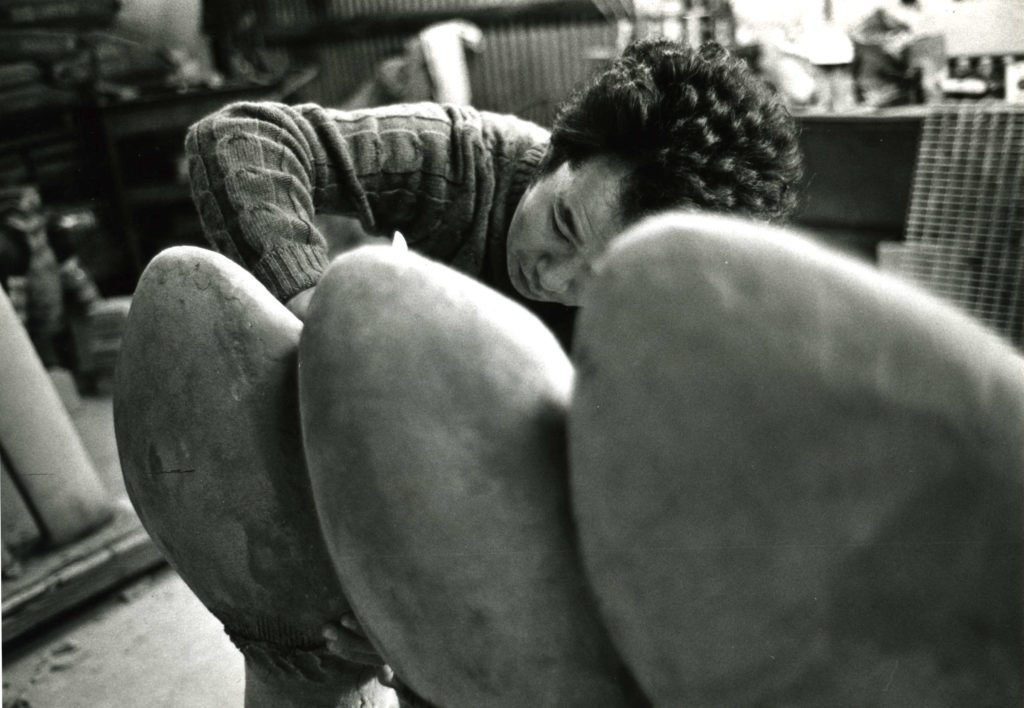
Jun Kaneko sculpting at his studio in Temple City, CA,1968. Photo: Courtesy of Jun Kaneko.
1969
Spring. Kaneko visits Japan and has a joint exhibition with his former painting teacher Satoshi Ogawa.
Fall. Kaneko enrolls at Claremont College and studies under Paul Soldner. He works both there and in his Temple City studio. During his time as a graduate student (1969-71), Kaneko experiments extensively in ceramics, photography, sound, and performance, expanding and challenging his concepts for developing his artwork.
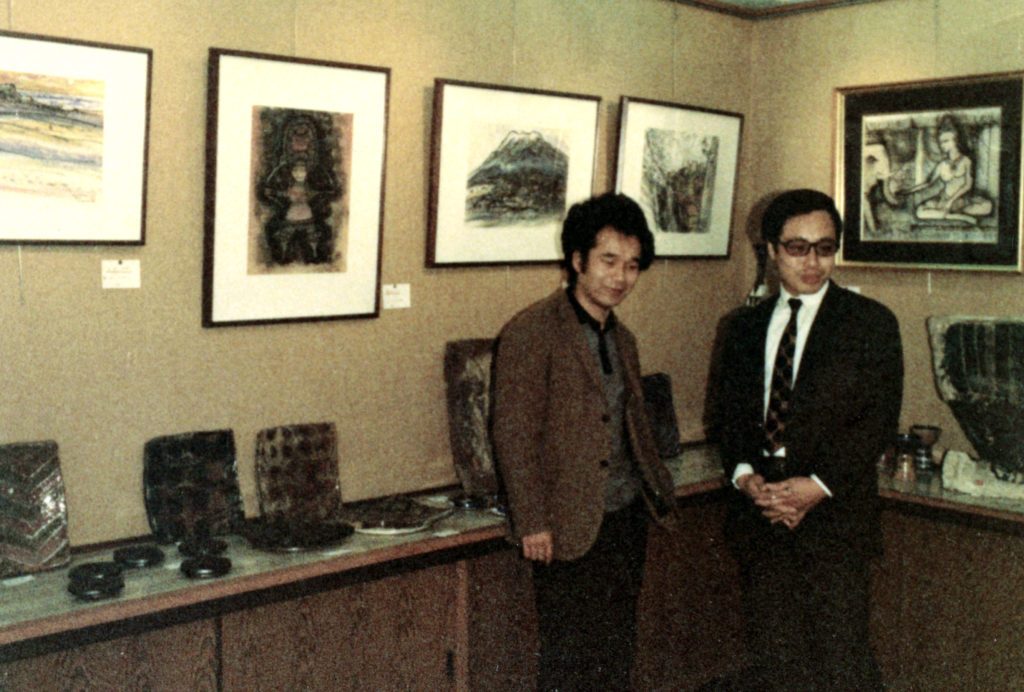
Jun Kaneko (left) and his former teacher Satoshi Ogawa at their joint exhibition in Nagoya. Photo: Courtesy of Jun Kaneko.
1971
May. Kaneko graduates from Claremont College Graduate School.
Summer. He travels to Japan and mounts an experimental exhibition at Mori’s Form Gallery in Osaka. Invitations are printed in white on white crumpled paper. The exhibition starts with an empty gallery without objects, the artist sitting in the space with the intention that whoever comes to the gallery will communicate with him and take the show off in a particular direction. He gives a lecture at the American Center in Nagoya, Japan, and elsewhere on contemporary American ceramics. He also sponsors and organizes a Clay Festival in Tokoname with Ryoji Koie.
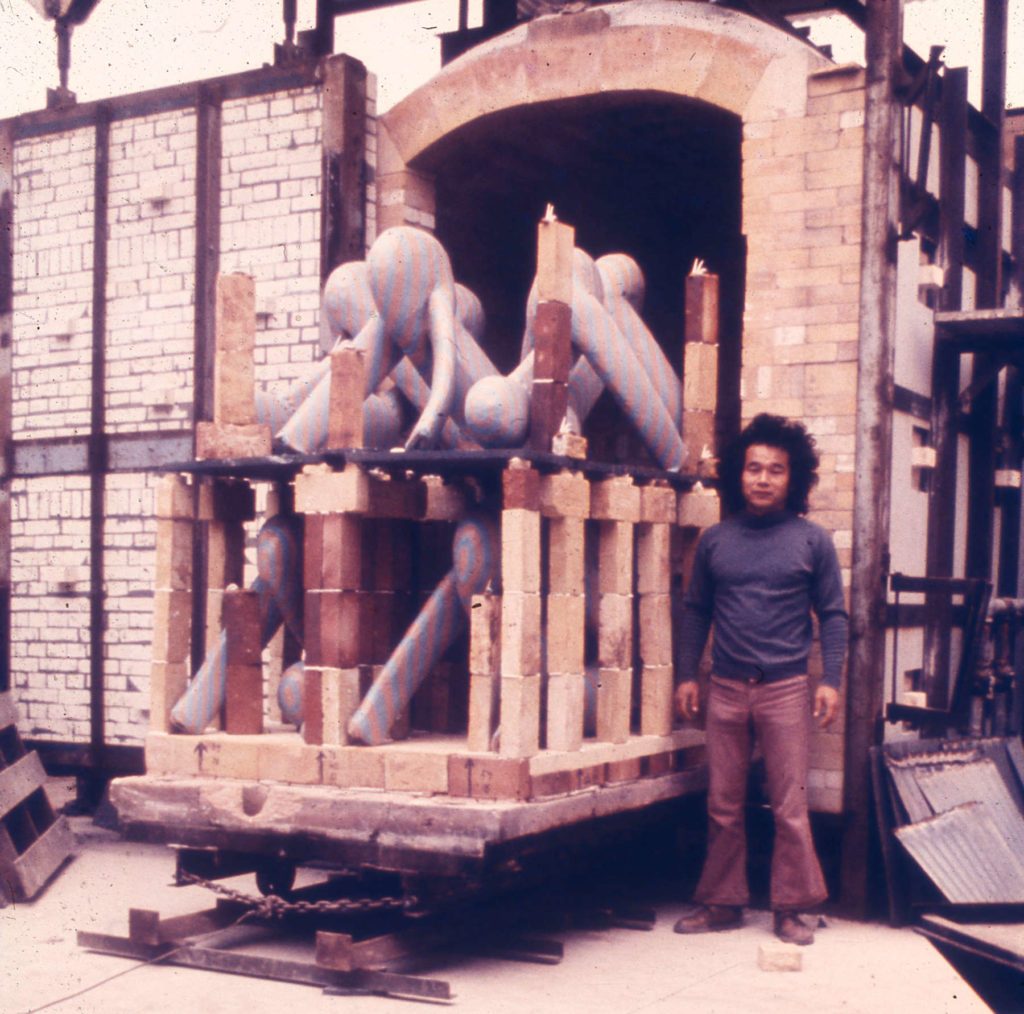
Jun Kaneko unloading ceramic Sanbon Ashi forms from a kiln, 1970. Photo: Courtesy of Jun Kaneko.

Jun Kaneko sitting in a kiln. Photo: Courtesy of Jun Kaneko.
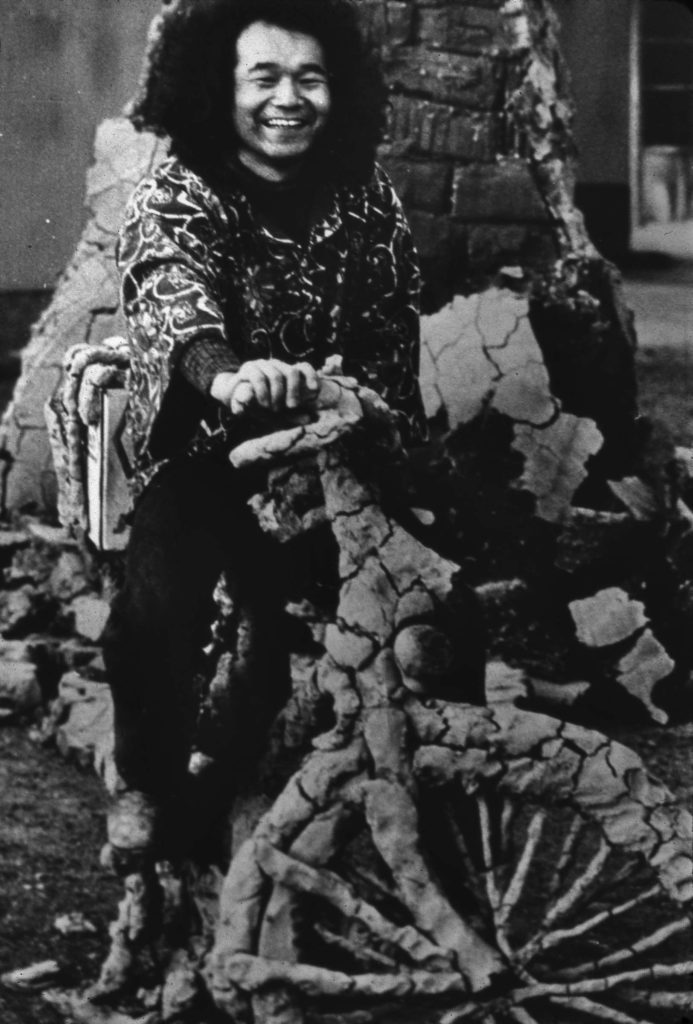
Jun Kaneko sitting on a bicycle covered in clay at his Clay Festival in Tokoname. Photo: Courtesy of Jun Kaneko.
1972
Spring. Kaneko returns to the US to take up the position of head of the ceramics department at the University of New Hampshire, Durham.
1973
Kaneko is offered a teaching position at the Rhode Island School of Design, Providence, and teaches there with Norman Schulman.
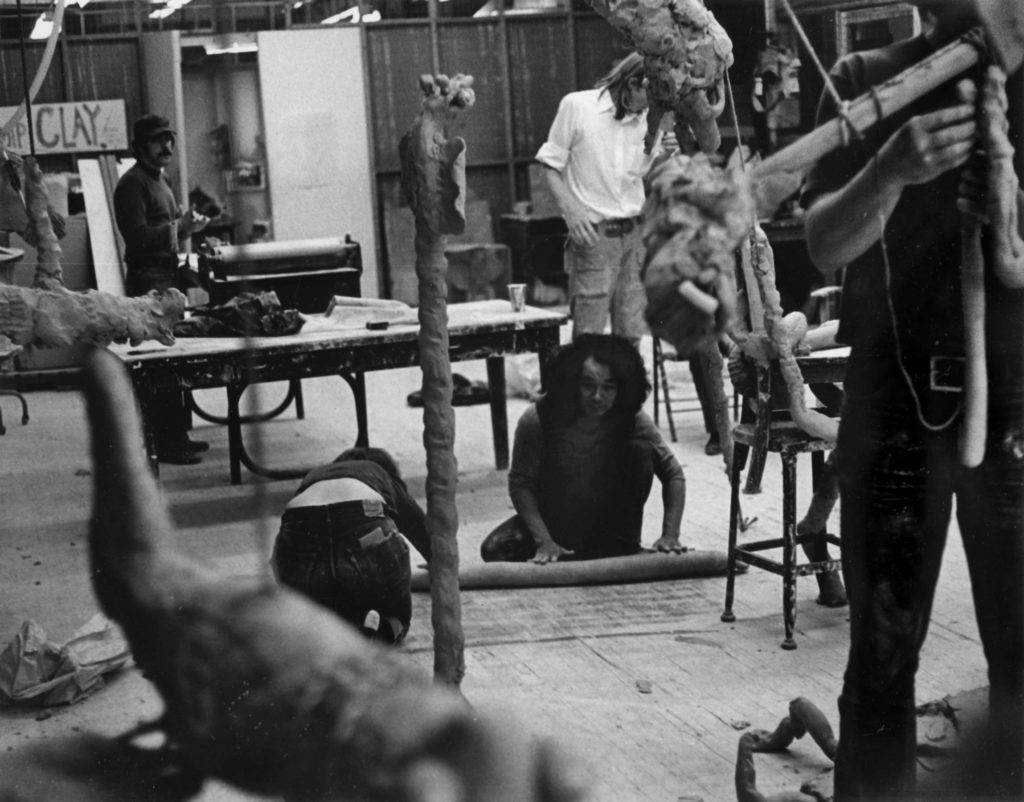
Jun Kaneko (center) teaching a clay workshop at University of Kentucky, Lexington. Photo: Pete Kuentzel.
1975
Spring. Kaneko moves back to Japan and starts construction of a house (1,500 square feet, 139 m2), a studio (2,000 square feet, 186 m2), and a kiln house (1,200 square feet, 111m2) in Nagura. This undertaking gives him his first experience of the large-scale environment and its sculptural possibilities, which becomes an important influence on his work. Construction continues for three years with the help of many friends and reaches completion in October 1978.
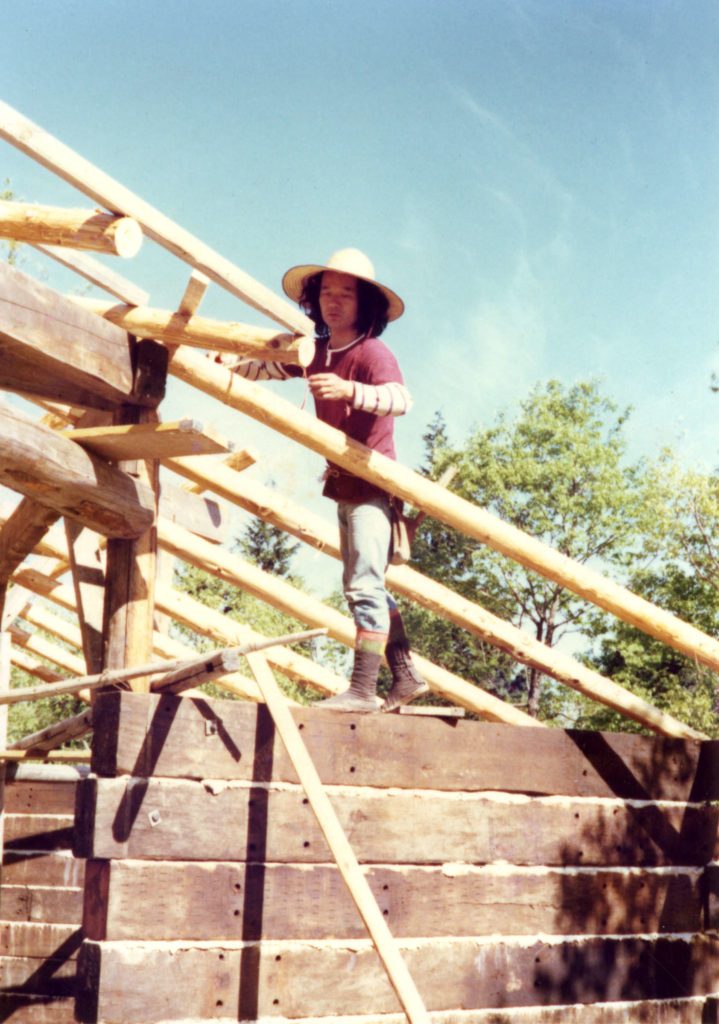
Jun Kaneko constructing his home and studio in Nagura, circa 1976. Photo: Courtesy of Jun Kaneko.
1977
Kaneko and Goro Suzuki travel through the southern part of Japan, for six weeks, in a 2-ton Toyota pick-up truck. They build a small shed on the back of the truck to live in.
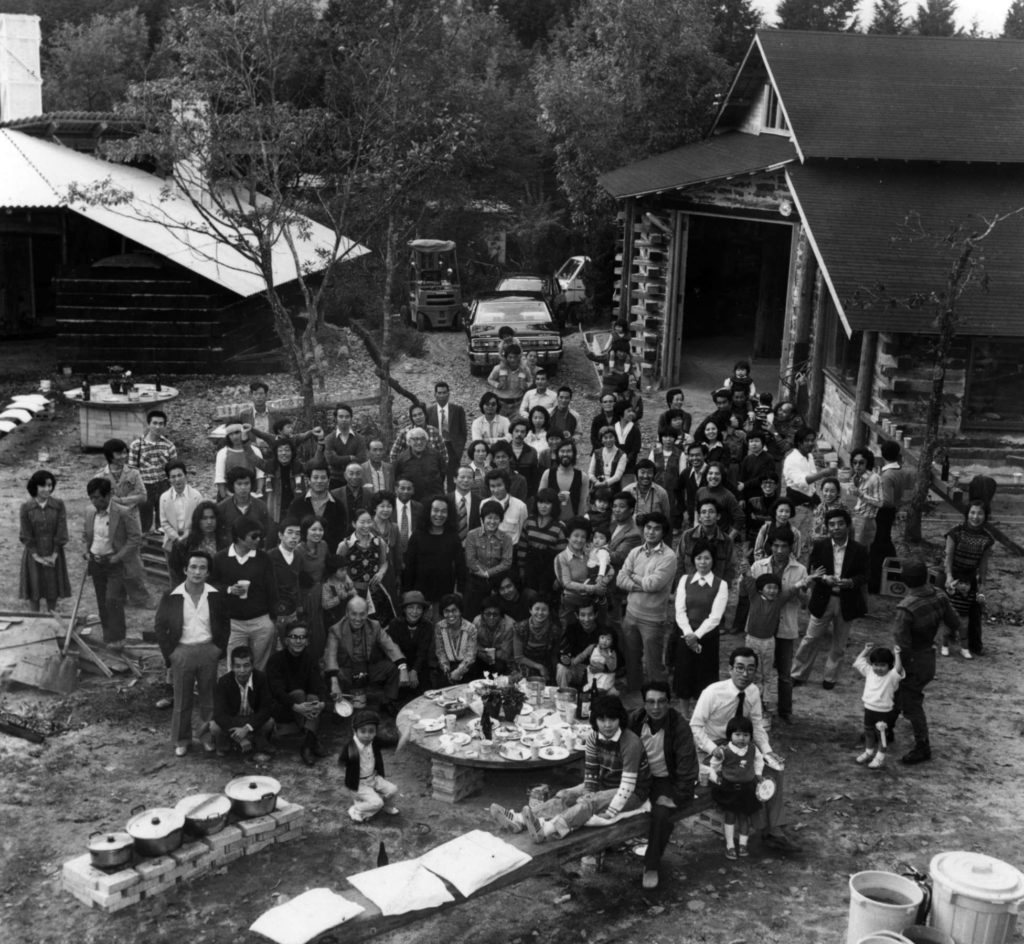
A party celebrating the completion of Kaneko’s home and studio in Nagura, 1978. Photo: Courtesy of Jun Kaneko.
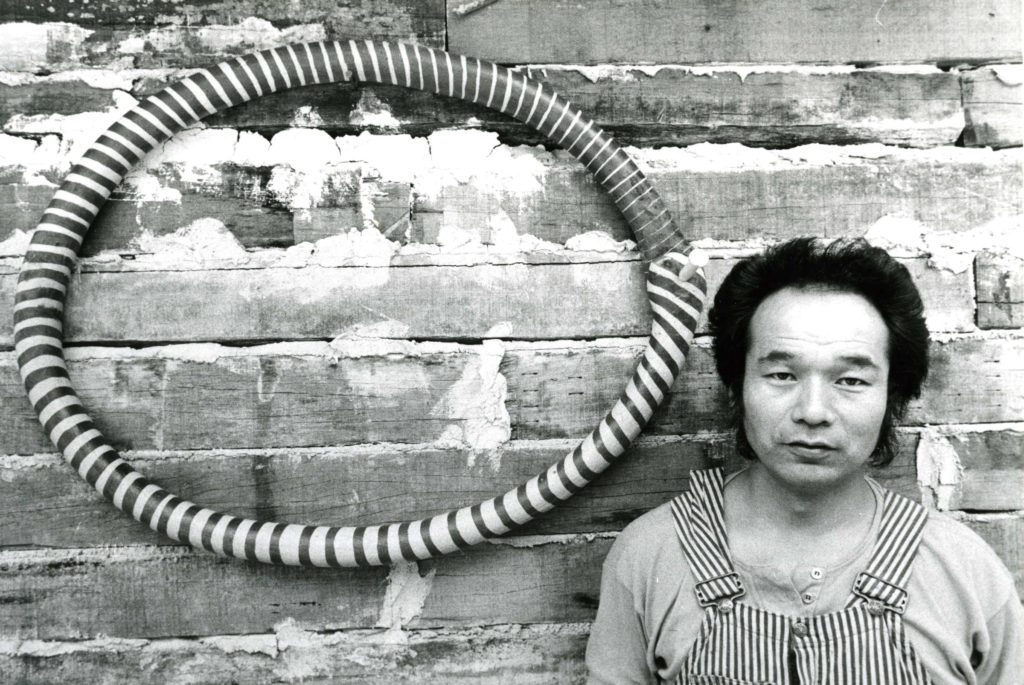
Jun Kaneko and a hoop sculpture outside his house in Nagura, 1978. Photo: Courtesy of Jun Kaneko.
1979
Kaneko travels to Korea for the first time, for two weeks, to investigate the making of large Korean kimchi jars.
February. He is invited to work for six months at the Clayworks Studio in Manhattan, New York. During his residency, he is also invited to work in textiles at The Fabric Workshop in Philadelphia, Pennsylvania, as well as being offered a teaching position as Head of the Ceramics Department at the Cranbrook Academy of Art in Bloomfield Hills, Michigan.
Fall. Kaneko’s position at Cranbrook begins with a two-year project, fixing and reorganizing the studio space, equipment and facilities. During the next 24 months, Kaneko and his students build seven new kilns for the school. He teaches there for seven years until 1986, when he moves to Omaha, Nebraska.
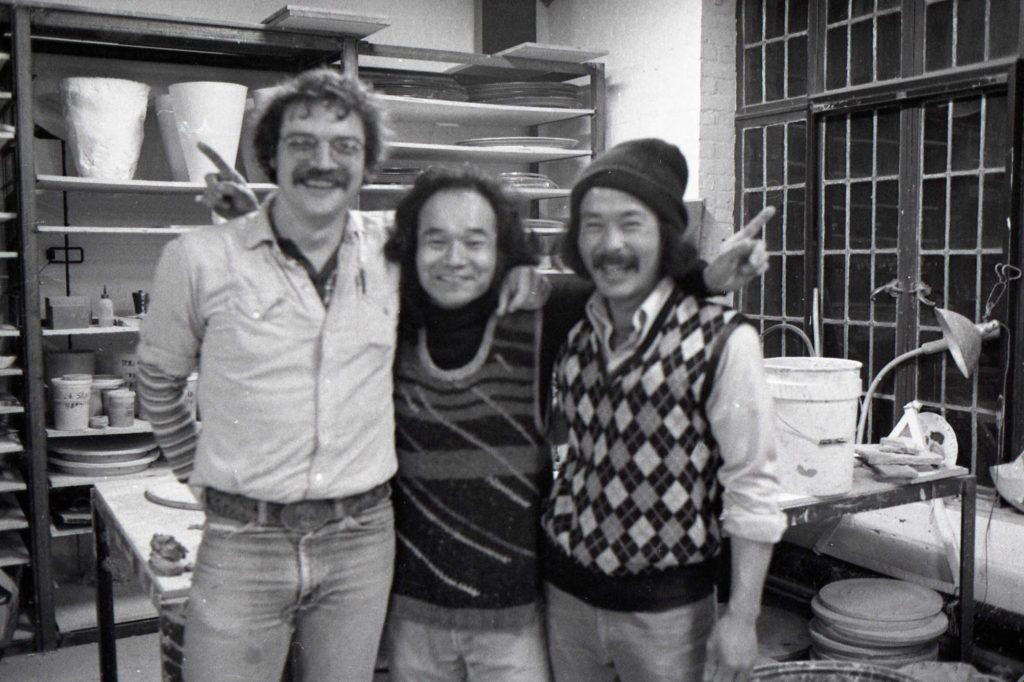
Jun Kaneko (center) with Terry Allen (left) and Ken Iwasama in the ceramic studio at Cranbrook Academy of art, 1980. Photo: Courtesy of Jun Kaneko.
1982
Kaneko gives his first workshop in Omaha, Nebraska.
1983
May. Kaneko embarks on his Omaha Project, his first large-scale endeavor, at the Omaha Brickworks. He fabricates four large “dangos,” 7 feet wide by 5 feet by 6 feet high (2.1×1.5×1.8m), weighing 5.5 tons each, and four large “slabs,” 8 inches high by 4 feet wide by 6 feet deep (20cmx1.2mx1.8m), weighing 1.5 tons each.
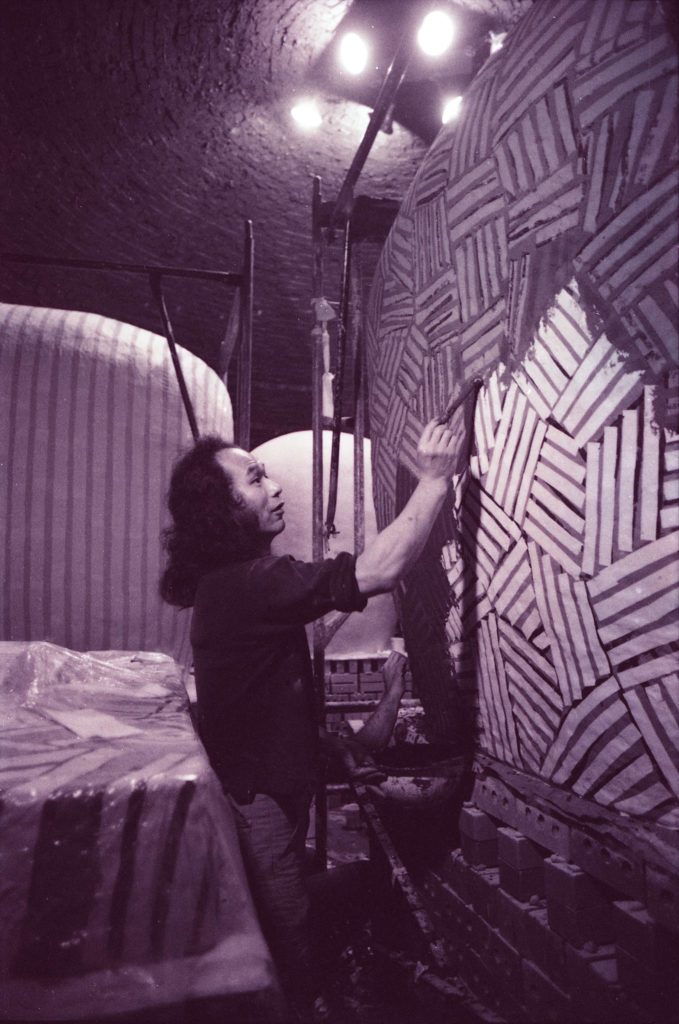
Jun Kaneko at the Omaha Brickworks. Photo: Courtesy of Jun Kaneko Studio.
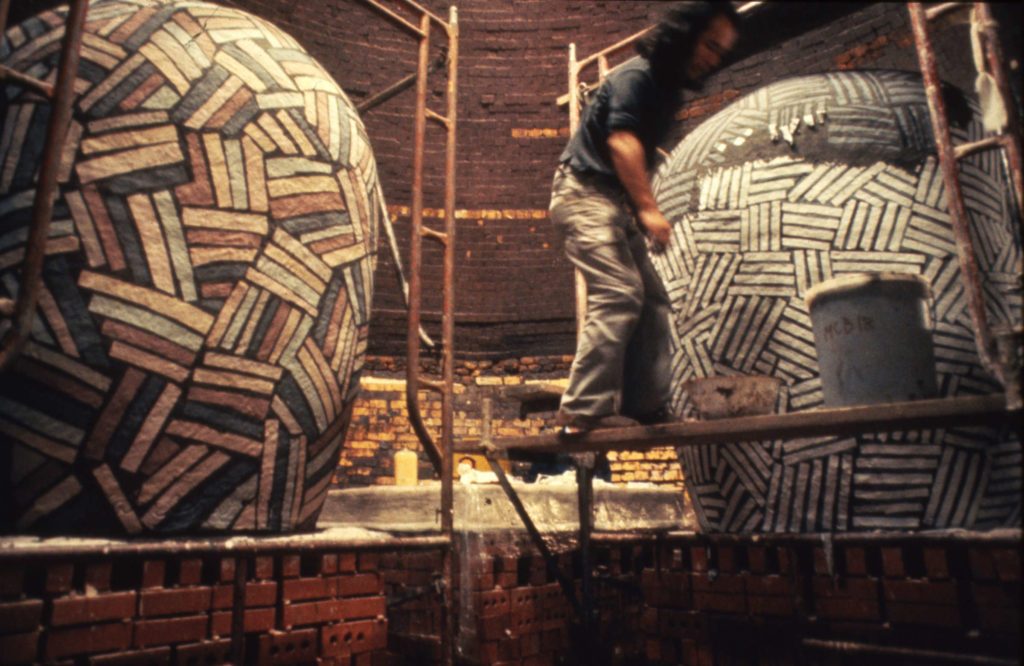
Jun Kaneko at the Omaha brickworks. Photo: Courtesy of Jun Kaneko Studio.
1984
January. Three of the Omaha Project dangos and three of the Omaha Project slabs emerge successfully from the kiln.
November (until March 1985). For 4 1/2 months, Kaneko travels around Europe for the first time. He visits Helsinki, Düsseldorf, Amsterdam, Paris, Geneva, Milan, Venice, Padua, Rome, Assisi, Perugia, Todi, San Gimignano, Florence, Pisa, Lucca, Petra Santa, Imperia, Nice, Barcelona, Granada, Malaga, Seville, Cordoba, Toledo, Cuenca, and Madrid.
1985
Summer. Kaneko visits Isamu Noguchi at his studio in Japan with Ryunosuke Kasahara.
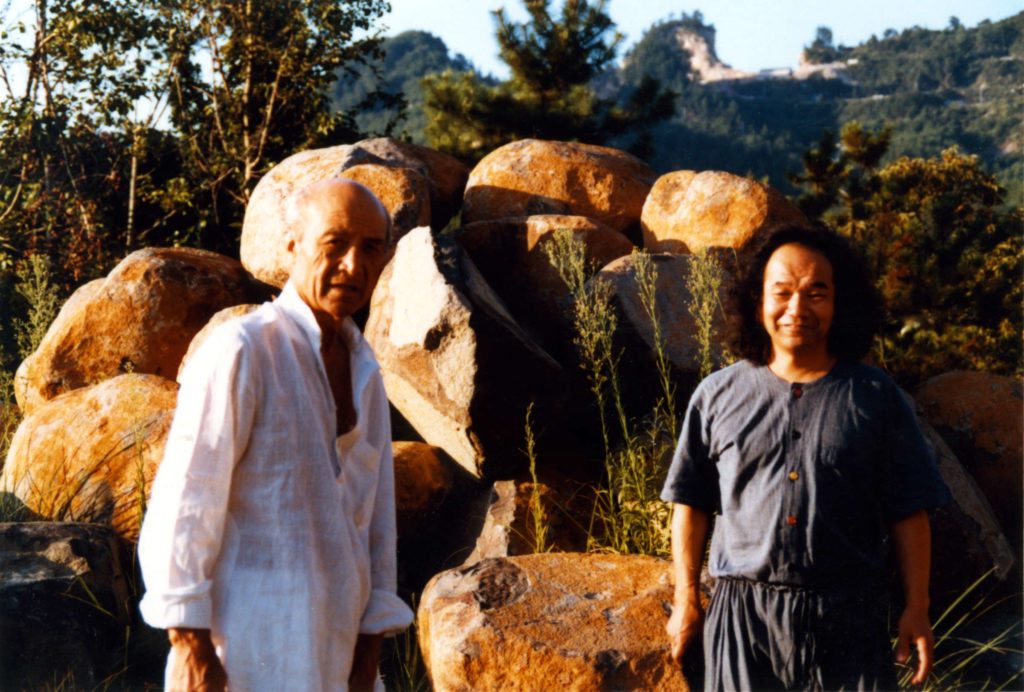
Isamu Noguchi (left) and Jun Kaneko in Japan. Photo: Courtesy of Jun Kaneko.
1986
Kaneko makes his Polka Dot Sidewalk installation, 75 feet wide by 150 feet long (22.9 x 45.7m), in front of The Art Museum of South Texas in Corpus Christi. He resigns from his teaching position at Cranbrook Academy of Art and moves to Omaha, Nebraska. There, he leases and develops a 7,000 square foot (650m2) studio and apartment at 616 South Eleventh Street. Co-founds Bemis Center for Contemporary Arts with Ree Kaneko, Lorne Faulk, and Tony Hepburn.
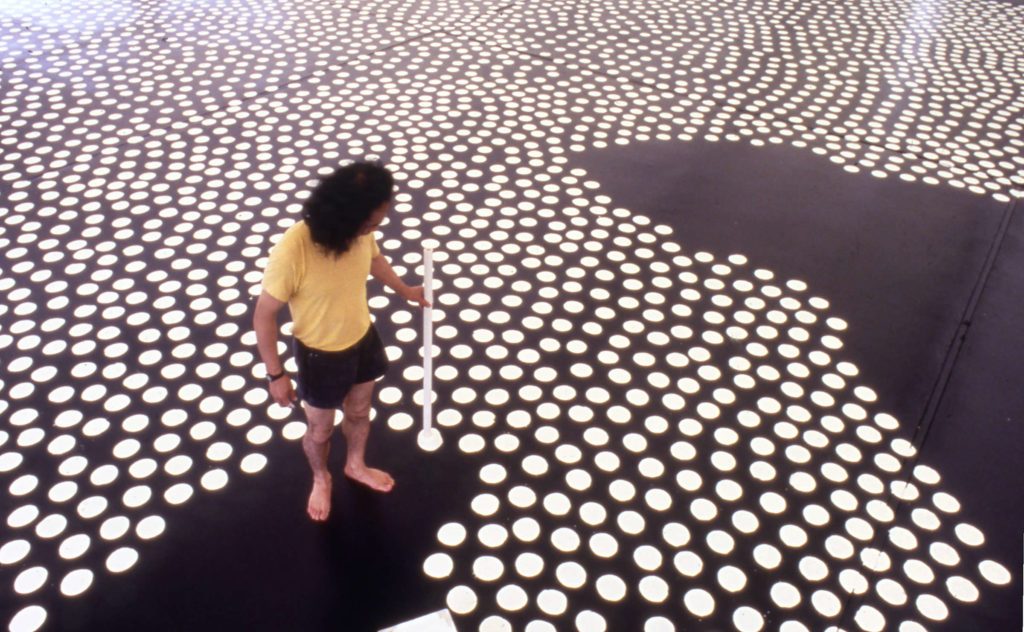
Jun Kaneko creating Polka Dot Sidewalk. Photo: Jun Kaneko Studio.
1987
June-September. Kaneko is invited to work at the Arabia ceramic factory in Helsinki, Finland. He makes Arabia Wall which inaugurates his interest in ceramic walls.
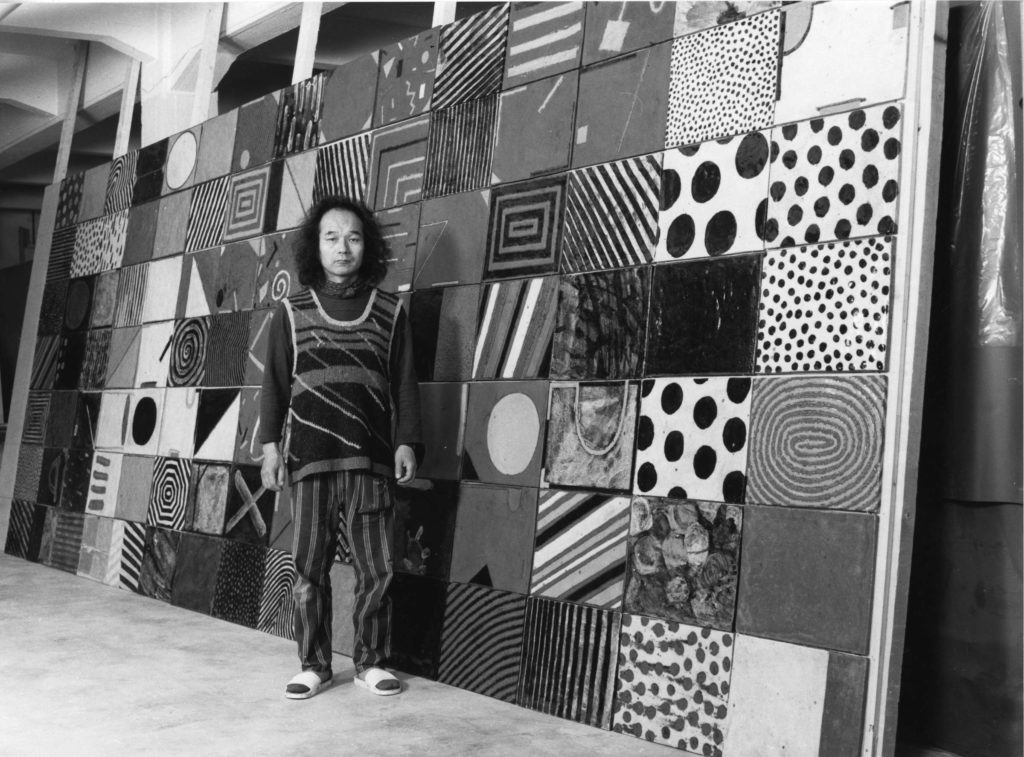
Jun Kaneko with Arabia Wall in Helsinki. Photo: Image courtesy Jun Kaneko Studio.
1988
Kaneko purchases a 38,000 square foot (3,530 m2), four-story building at 1120 Jones Street, Omaha, and works on developing it into his studios and living space.
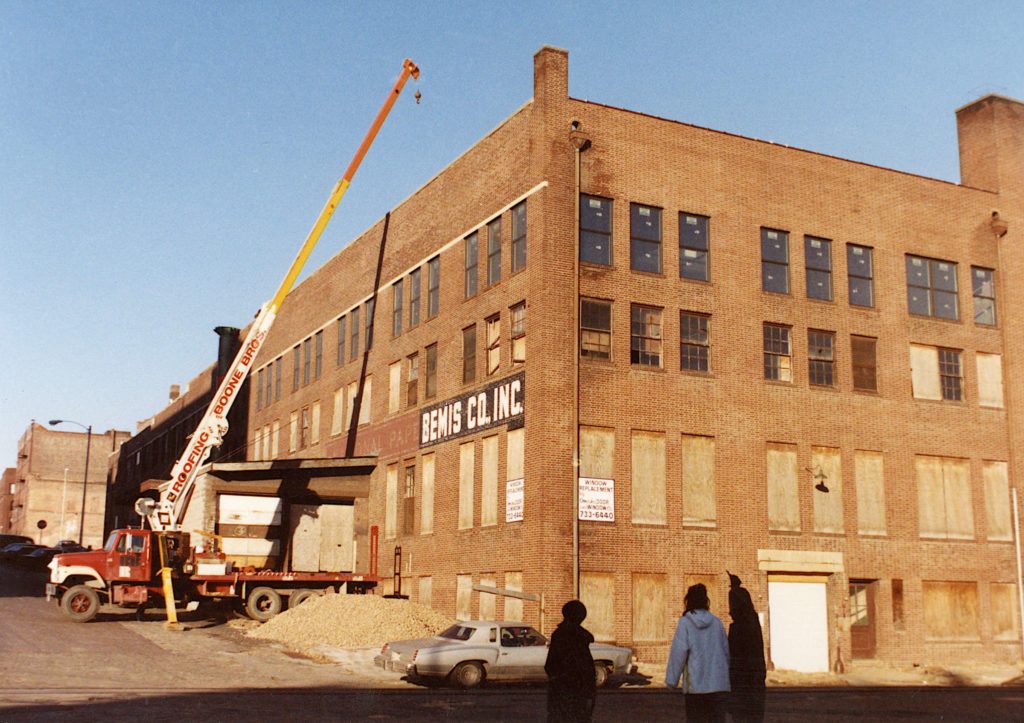
1120 Jones Street studio under renovation. Photo: Courtesy of Jun Kaneko Studio.
1989
Kaneko continues work on the renovation of his new studio space.
November-December. He travels to Japan for an exhibition, to work at Shigaraki, and visits Korea.
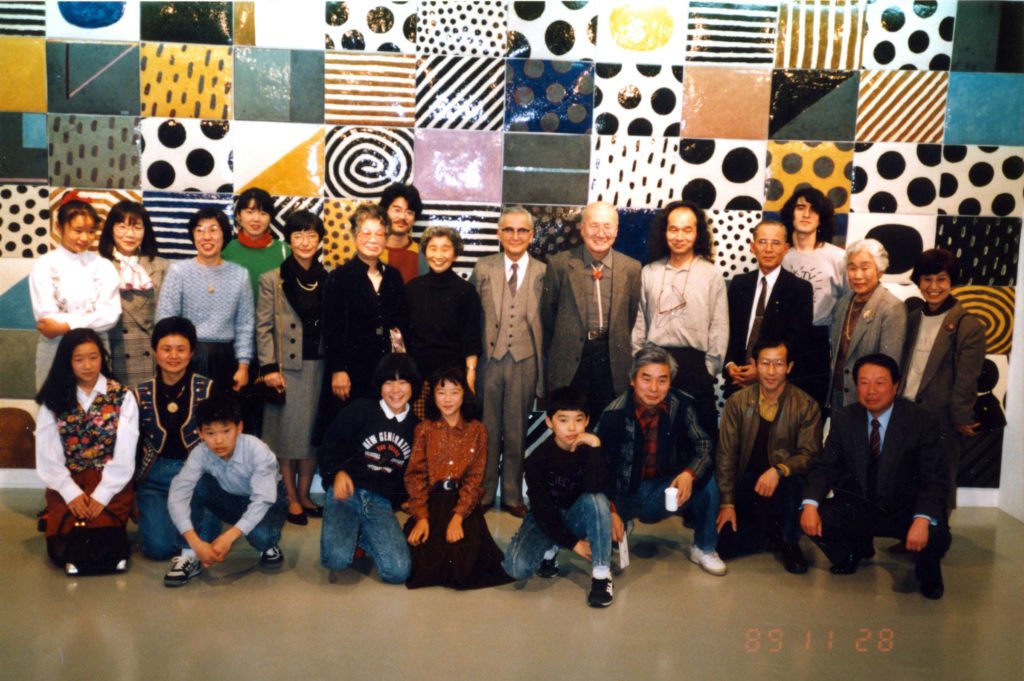
Jun Kaneko with his family in front of Nagoya Wall at an exhibition in Japan. Photo: Courtesy of Jun Kaneko.
1990
Spring. Kaneko’s parents travel to the US for the first time to visit their son. Together, they tour the places where Kaneko has lived, studied, taught and worked since 1963.
Summer. Kaneko moves from his leased studio and apartment into his own new studio.
June. He attends the International Ceramic Symposium in Oslo, Norway, and revisits Helsinki and Stockholm.
1991
March. Kaneko installs a public art commission of ten dangos at Phoenix Sky Harbor airport.
April. The Shigaraki Work Center opens in Japan. Kaneko works there running a workshop and giving demonstrations and lectures.
May. Kaneko visits Fremont, California, for the first time to see a large sewer pipe factory, Mission Clay Products, to consider the possibility of producing a large-scale series of works in their beehive-shaped kilns.
October. Kaneko returns to Shigaraki to work and fire the first dangos made in Japan. He travels to Korea and meets Sang Ho Shin for the first time.
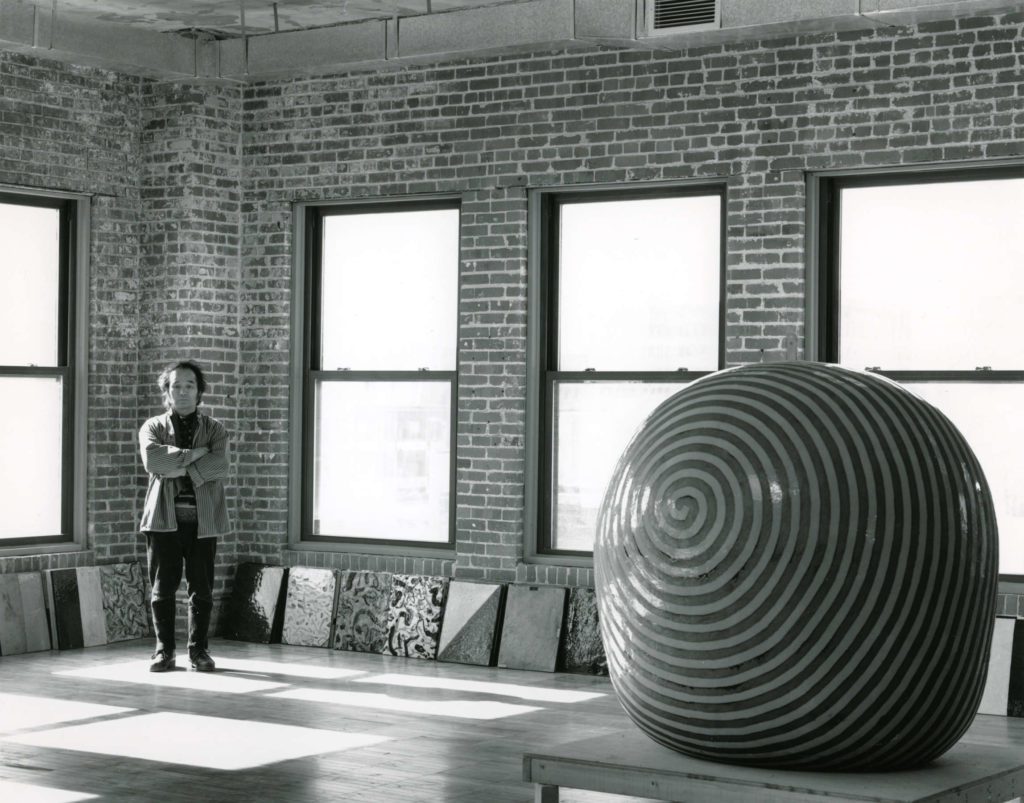
Jun Kaneko in his studio with a finished dango and wall slabs. Photo: Dirk Bakker.
1992
April (to March 1994). Kaneko works on the Fremont Project.
May-September. Six large dangos, measuring 11 feet high by 6 feet wide by 3 feet deep (3.4×1.8x.9m), are constructed. They will slowly dry until March 1994.
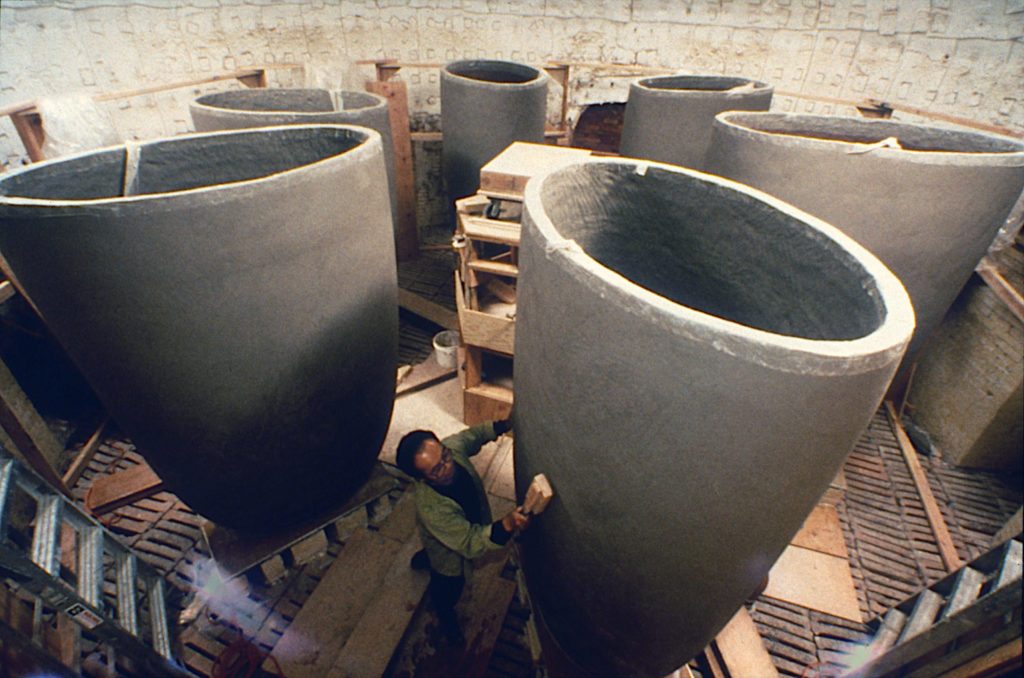
Jun Kaneko shaping the walls of Dangos in the kiln during the Fremont Project. Photo: Takashi Hatakeyama.
1993
Throughout the year, the Fremont Project dangos continue to dry and Kaneko commutes monthly between Omaha and Fremont to monitor their progress.
February. Kaneko fires two large dangos in a wood kiln, owned and operated by John Balistreri in Denver, Colorado.
May. He travels to Europe to visit the European Ceramic Work Centre in ‘s-Hertogenbosch, the Netherlands.
June. The Fremont Project dangos are brought out from under their plastic tents.
November. Susan Peterson and Robert Schwarz join Kaneko in Japan to visit Nagoya, Tokyo, Kyoto, and Shigaraki.
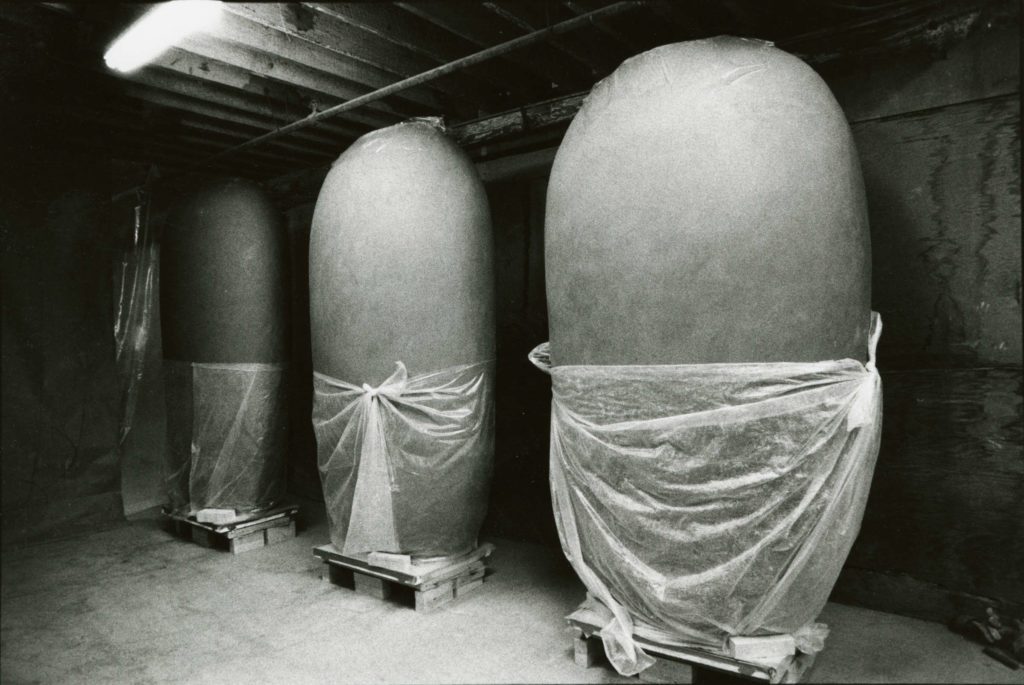
Fremont Project Dangos draped in plastic to control the rate of drying. Photo: Kozo Miyoshi.
1994
January. Kaneko exhibits at the Bentley Gallery in Scottsdale, Arizona, and visits Mexico City for the first time.
March. He attends the annual NCECA (National Council on Education in the Ceramic Arts) conference, held in New Orleans, Louisiana, that year, and receives their Lifetime Achievement Award.
March-September. Kaneko unloads the bisque firing of a dozen 8-foot (2.4m) dangos and starts the bisque firing for the 11-foot (3.4m) dangos at Mission Clay Products. The glazing process begins first on the 8-foot dangos, while the 11-foot pieces are in the bisque. Kaneko is stricken with shingles and half of his face becomes paralyzed. He loses his sense of balance. All work stops for four weeks. Slowly Kaneko begins working again, taping his left eyelid open so he can see. Three months later, all dangos emerge from the kiln successfully. A huge celebration is held at Mission Clay Products with over 200 guests from the US and Japan.
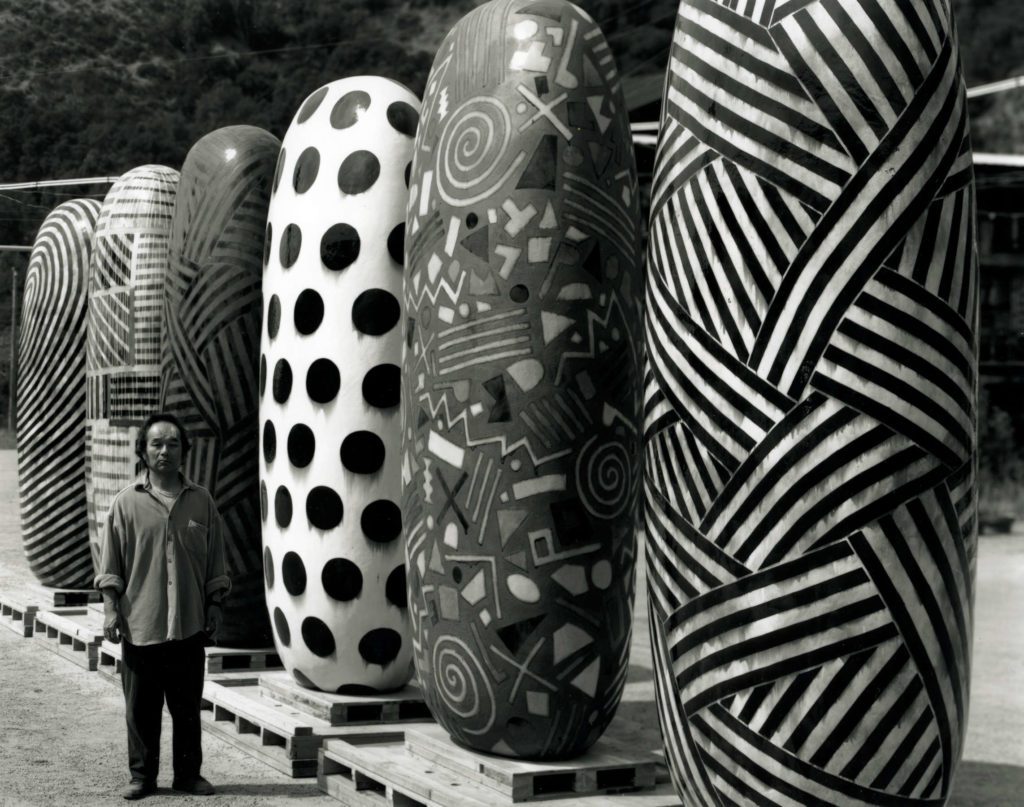
Jun Kaneko with completed Fremont Project Dangos. Photo: Kozo Miyoshi.
1995
January. Kaneko goes to Hawaii for the first time, where he creates a body of works on paper.
February. Construction of Kaneko’s new larger kiln in his Omaha studio starts.
March. Kaneko travels to Japan and to a site in North Carolina for a large public project.
April. Kaneko works with Peter Voulkos at the Shigaraki Ceramic Center, Japan. Susan Peterson and her son, Taäg, visit them there.
July. The new kiln in the Omaha studio is completed.
August–October. Kaneko travels in Germany and works at the European Ceramic Work Center in ‘s-Hertogenbosch, Netherlands.
November. Travels to Japan for an exhibition at the Maruei Gallery and the Takagi Gallery, Nagoya.
December. Works at the Shigaraki Ceramic Center, Japan. While there, he sees an exhibition by Toshiko Takaezu in Kyoto and travels to Korea.
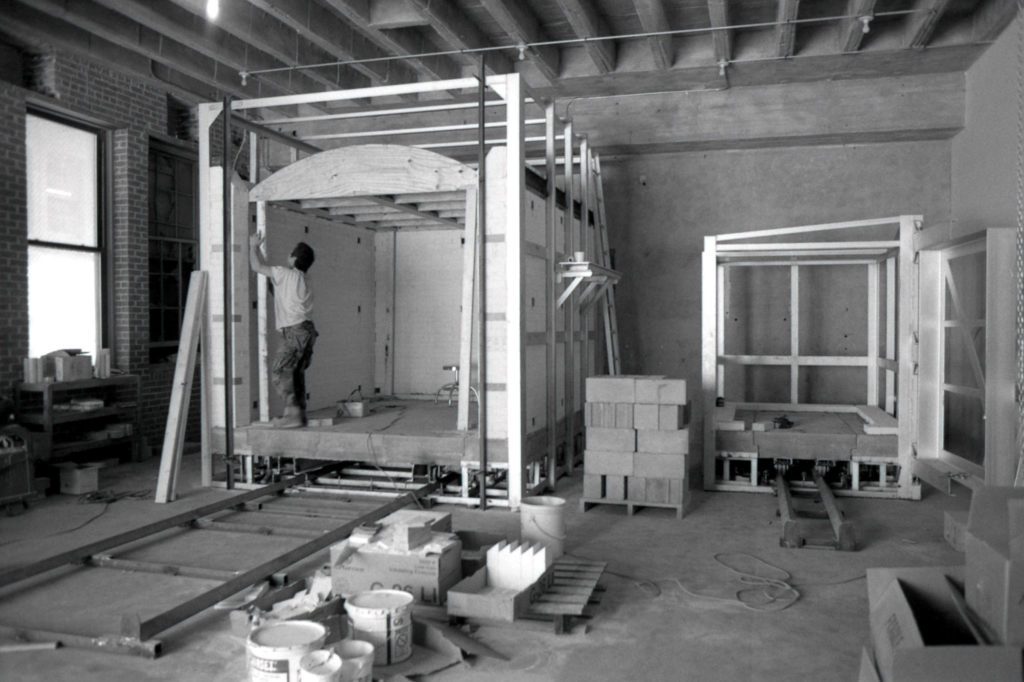
Kazuaki Sugi building kilns at Jun Kaneko Studio. Photo: Susan Schonlau.
1996
March-May. Kaneko and Peter Voulkos have an exhibition at the Kenji Taki Gallery in Nagoya of works made at Shigaraki. Kaneko returns to the European Ceramic Work Centre, the Netherlands, to glaze and finish the work he started there the previous year. This is the first time he experiments with low-fire glazes on a major group of works and discovers some of their new possibilities.
May. Kaneko moves everything from the Nagura studio he completed in 1978 to the Omaha studio.
June. He travels to Finland for an exhibition with Tony Cragg, Xavier Toubes, Angel Garraza, and Radoslaw Gryta, and on through France and Italy, to Carrara, to visit Manuel Neri’s studio and look at the local marble. He goes to Todi to see Nino Caruso, and visits Betty and George Woodman at their studio in Florence.
July. Kaneko travels to England and Germany. A major exhibition of works from his European Ceramic Work Centre residency opens at the Frans Hals Museum in Haarlem, the Netherlands. Over 16,000 people view his work.
August. He visits the Salt Palace convention center and symphony hall in Salt Lake City for a proposed public art project. It is a large tile wall called Salt Palace Wall.
September. He installs his public project for North Carolina. It is a plaza called Liquid Order and is installed at the North Carolina Graduate Engineering Center.
October. Kaneko exhibits at Klein Art Works, Chicago, and LewAllen Contemporary in Santa Fe, New Mexico, and travels throughout the US with his friends Goro and Yoshiko Suzuki.

Jun Kaneko sculpting at EKWC. Photo: Jun Kaneko Studio.
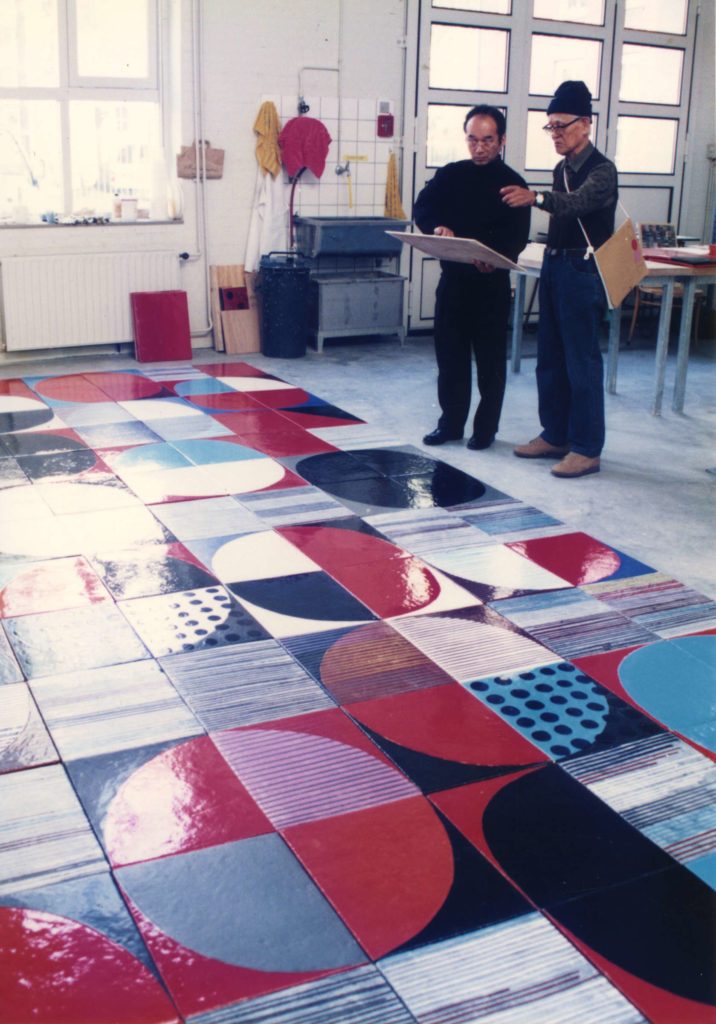
Jun Kaneko and Kenkichi Sugimoto (right) at EKWC. Photo: Jun Kaneko Studio.
1997
January-February. Kaneko works on a series of drawings in Hawaii.
March-April. The Aichi-Ken Sannomaru Project installation is completed. Kaneko goes to Korea to visit Sang Ho Shin and his wife Yoon Sook Han, and to investigate handmade Korean rice-paper. He has hundreds of large sheets made and sent back to his studio. He also visits the Jin Bae studio complex.
June. Kaneko conducts a workshop at Penland School of Crafts, North Carolina.
August. He starts to test low-fired material in Omaha.
September. Exhibition opens at the Susanne Hilberry Gallery, Bloomfield Hills, Michigan.
October. A 70-piece exhibition of Kaneko’s work from the European Ceramic Work Centre opens at the academy of Art in Leuven, Belgium. Kaneko travels to Bilbao, Barcelona, Madrid, Majorca, Ibiza, Nice, and Amsterdam. He visits artist Mathijs Tsunissen van Manen and his family, both in Ibiza and Amsterdam.
November. Kaneko visits Therman Statom’s studio in Escondido, California.
December. He travels to Hawaii to work on a series of drawings.
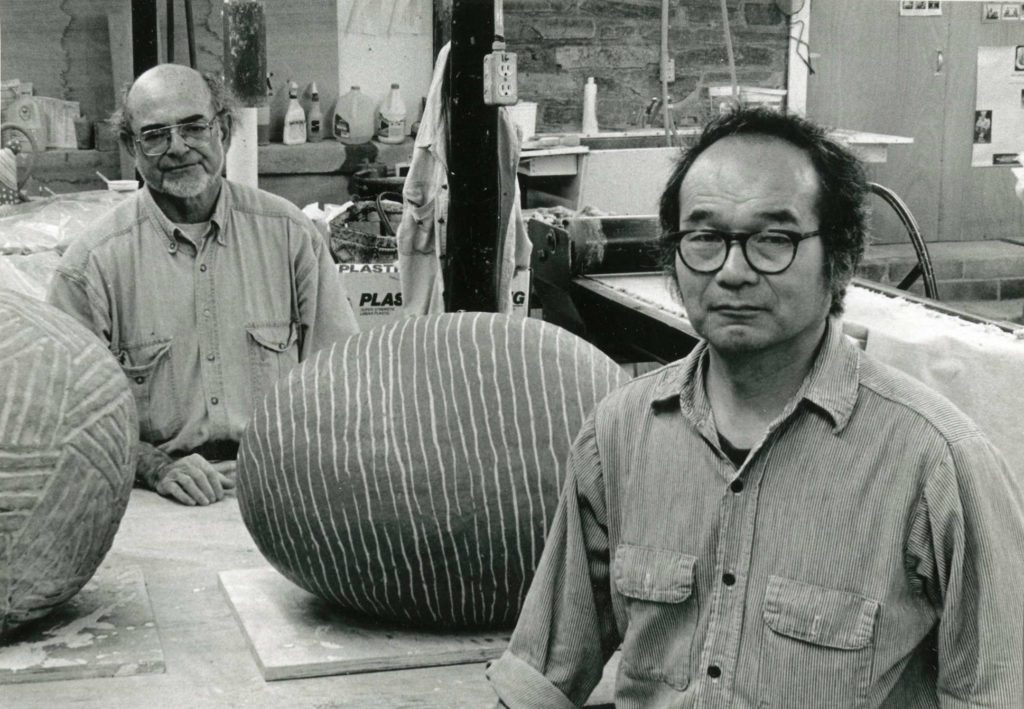
Norm Schulman (left) and Jun Kaneko at Penland. Photo: Courtesy of Jun Kaneko Studio.
1998
February-March. In Texas, Kaneko lectures at the Modern Art Museum in Fort Worth. He attends the NCECA conference. A Chicago exhibition opens at Klein Art Works.
April-May. Kaneko lectures at the Oakland Museum. He has a San Francisco exhibition at the Dorothy Weiss Gallery. He also visits Dale Chihuly at his boathouse studio in Seattle and participates in a week-long conference at the University of Alberta in Edmonton, Canada.
June. He purchases his third warehouse in Omaha. It has 50,000 square feet (4,645m2) and is the future site of the KANEKO. He goes back to Japan and is a member of the jury for the Tajjimi International Ceramic Competition and also conducts a workshop there.
July. Kaneko goes to Hawaii for a meeting about the Waikiki Aquarium Public Art Project. He also meets with curator Jennifer Saville at the Honolulu Academy of Art to discuss a forthcoming exhibition.
August. Kaneko Goes to Acadia Summer Art Program (ASAP) in Maine. There, he works on architectural plans with Kippy Boulton Stroud for a large studio in Maine for Stroud’s program. He also works on some smaller drawings.
September. Kaneko experiments with glass works at Bullseye Glass in Portland. He has a solo exhibition at Lewis & Clark College.
October. An exhibition opens at the Leedy-Voulkos Gallery, Kansas City, Kansas.
November-December. In Omaha, Kaneko continues his studio work and renovation of purchased buildings.
1999
January. An exhibition opens at the Bentley Gallery, Scottsdale, Arizona. Kaneko returns to Hawaii and begins a new series of drawings.
March. Kaneko attends NCECA in Columbus, Ohio. His sister, Sayaka Inui, passes away.
April-May. Kaneko finishes tile fabrication for the University of Connecticut commission. He returns to Japan and Hawaii.
June. A Kaneko piece is shown at the Neuberger Museum Biennial Exhibition of Public Art, Purchase, New York.
August. Kaneko is in Bar Harbor, Maine, all month, working on a series of large paintings in a space provided by Kippy Boulton Stroud at the Acadia Summer Art Program (ASAP).
September. Kaneko has an exhibition at the Art Center of Hargate, New Hampshire. He also attends the University of Iowa Wood Fire Conference.
October. Kaneko works on the Omaha Steaks Wall commission which will be installed in their main headquarters. An exhibition opens at LewAllen Contemporary in Santa Fe, New Mexico. Kaneko also lectures at Santa Fe Clay and at the Northern Clay Center, Minnesota.
November-December. Peter Voulkos, John Balistreri, and Rudy Autio come to Omaha to work in Kaneko’s studio.
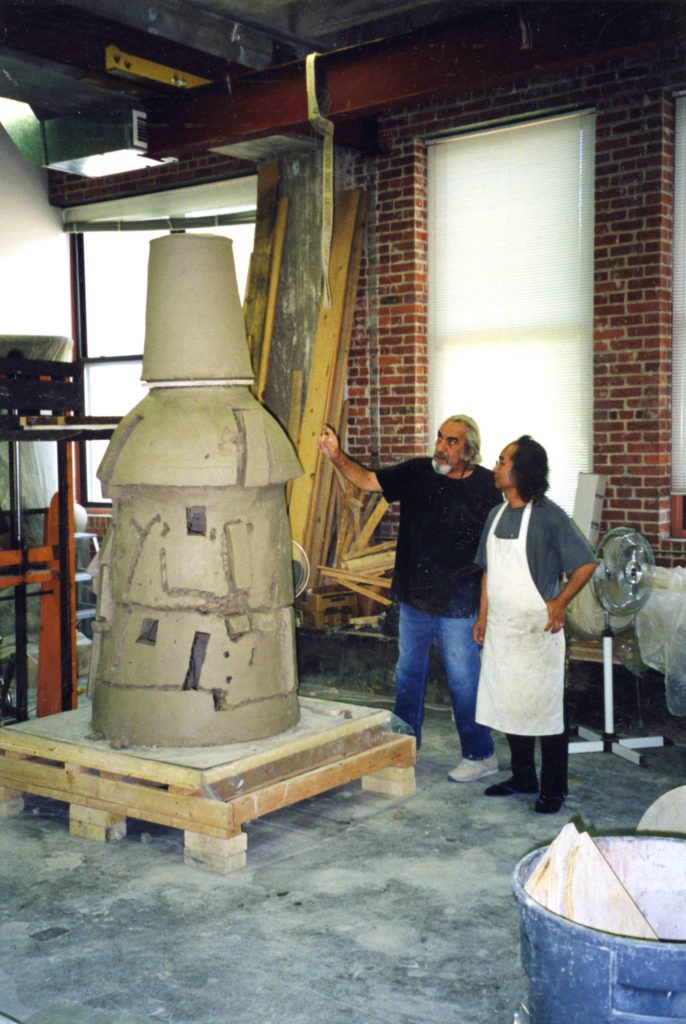
Peter Voulkos (left) and Jun Kaneko at Kaneko’s studio in Omaha. Photo: Jun Kaneko Studio.
2000
January-February. Susan Peterson travels to Omaha to begin work on a book project. Kaneko receives the Beaverton City Library Project commission and begins work on tile wall fabrication. Laurence King visits Kaneko’s studio in Omaha.
March-April. Kaneko attends NCECA in Denver and is offered an exhibition at the Denver Contemporary Art Museum by its director Mark Masuoka. A solo exhibition opens at Imago Gallery, Palm Desert, California.
May-June. A two-month long trip is planned for Japan, Korea, and an extensive China/Taiwan ceramics tour. Sites scheduled to visit include the Great Wall, the Forbidden City, the Terracotta Soldiers, Jingdezhen, and the National Palace Museum, Taipei, plus numerous artists’ studios and clayworks.
September. Kaneko dedicates a public commission in Portland, Oregon. He travels to London, New York, and Toronto.
October. Kaneko opens an exhibition at Traver Gallery in Seattle. He travels to Japan with Robert and Karen Duncan.
December. Peter Voulkos, John Balistreri and Rudy Autio return to Kaneko’s Omaha studio to glaze. Goro Suzuki joins the work session.
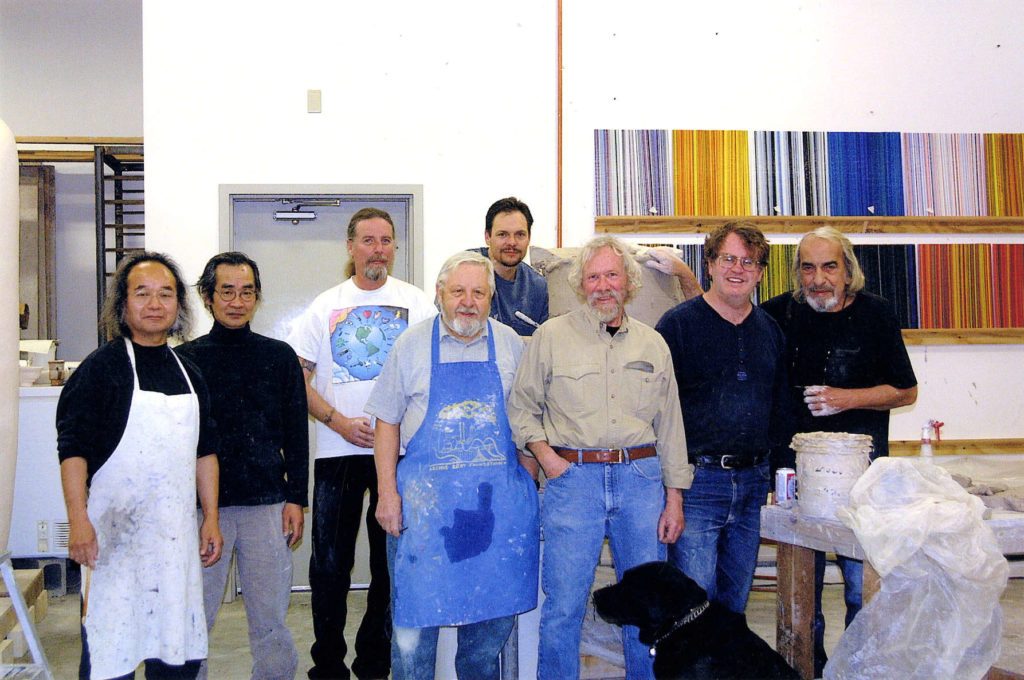
Work session at Jun Kaneko Studio. From left to right: Jun Kaneko, Goro Suzuki, Michael Sarich, Rudy Autio, John Balistreri, Gerry Eskin, Jimmy Clark, Peter Voulkos.
2001
January. Kaneko travels to Honolulu for the dedication of his public art commission for the Waikiki Aquarium and continues to his Kauai studio to work on a series of large-scale Korean rice paper drawings.
March. Kaneko works at Bullseye Glass.
April. He travels to New Zealand and Australia to attend and conduct a workshop at Clayfest Gulgong Ceramics Conference.
May. Kaneko opens an exhibition at the Honolulu Academy of Art.
June. He creates a series of 100 Wall Slabs at the European Ceramic Work Center, culminating in an installation exhibit.
July. Kaneko accepts an invitation to work at Franz-Meyer in Munich, Germany experimenting with architectural glass.
August. He conducts workshop in tandem with Peter Voulkos at the international Ceramic Festival in Korea and travels in Japan.
December. Peter Voulkos, John Balistreri, Rudy Autio return to Kaneko’s studio to start new work session.
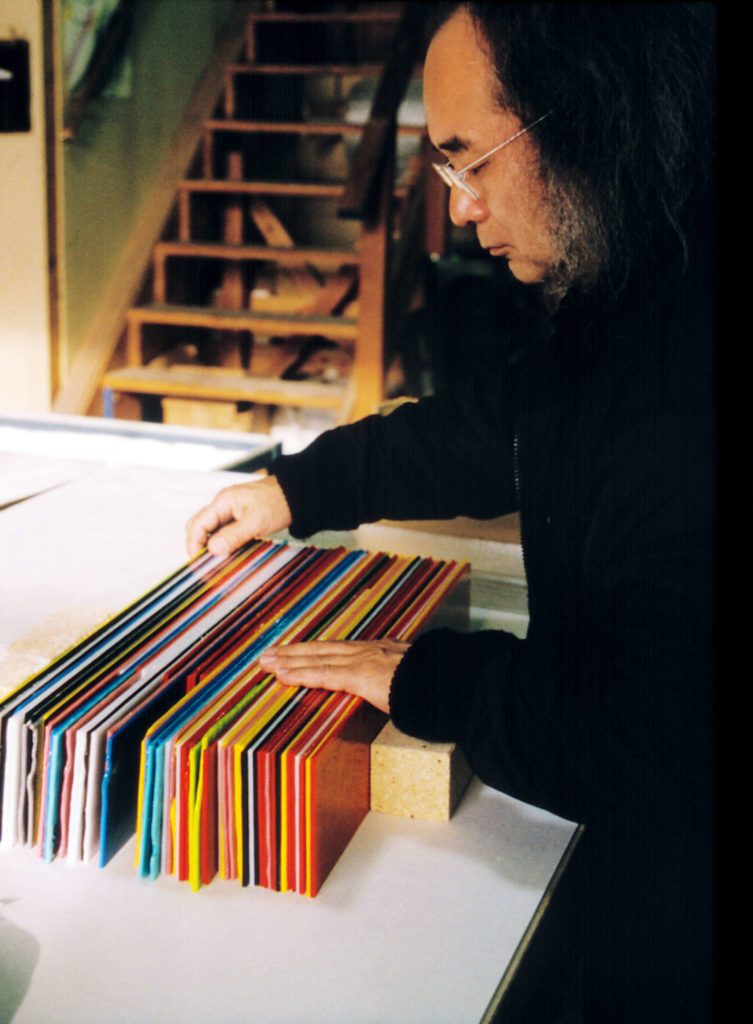
Jun Kaneko arranging colored glass pieces at Bullseye studio. Photo: Ree Kaneko.
2002
January. Kaneko works on a series of large-scale drawings at his Hawaii studio.
March. Installation of tile wall for the Aquarium Station public art project in Boston begins.
April. Kaneko attends Peter Voulkos memorials at the Oakland Museum of Art and Peter Voulkos’ Dome Studio.
June. Work starts on a series of cast bronze heads at Artworks Foundry in Berkeley.
July. Renovation begins on the KANEKO facility, a non-profit center for creativity and research founded by Ree and Jun Kaneko.
August. Kaneko works on a series of large drawings at a space provided by Kippy Boulton Stroud at Acadia Summer Art Program (ASAP) in Maine.
September. Kaneko attends Gallery Kasahara’s 30th anniversary exhibition which includes Kaneko’s work. He then travels to China.
October. Mark Mack visits Kaneko’s studio meeting him for the first time.
November. Kaneko opens an exhibition and lectures at the Holter Museum in Helena and visits Rudy and Lela Autio’s studio.
December. He travels to Los Angeles and onto Kauai to work at his Hawaii studio.
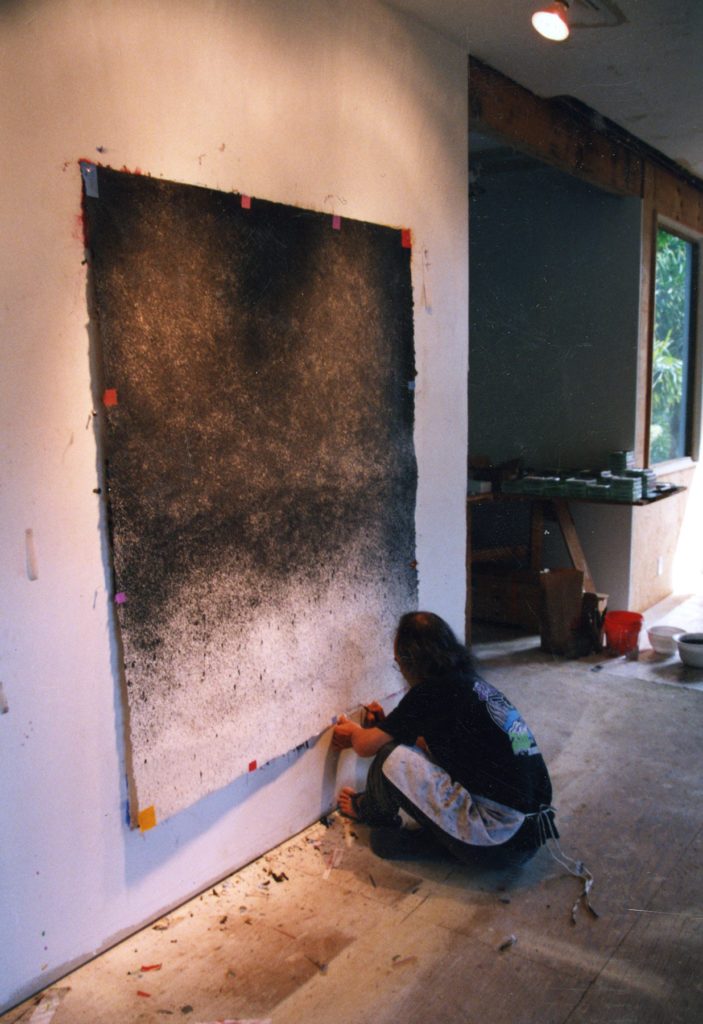
Jun Kaneko drawing on rice paper in Hawaii. Photo: Ree Kaneko.
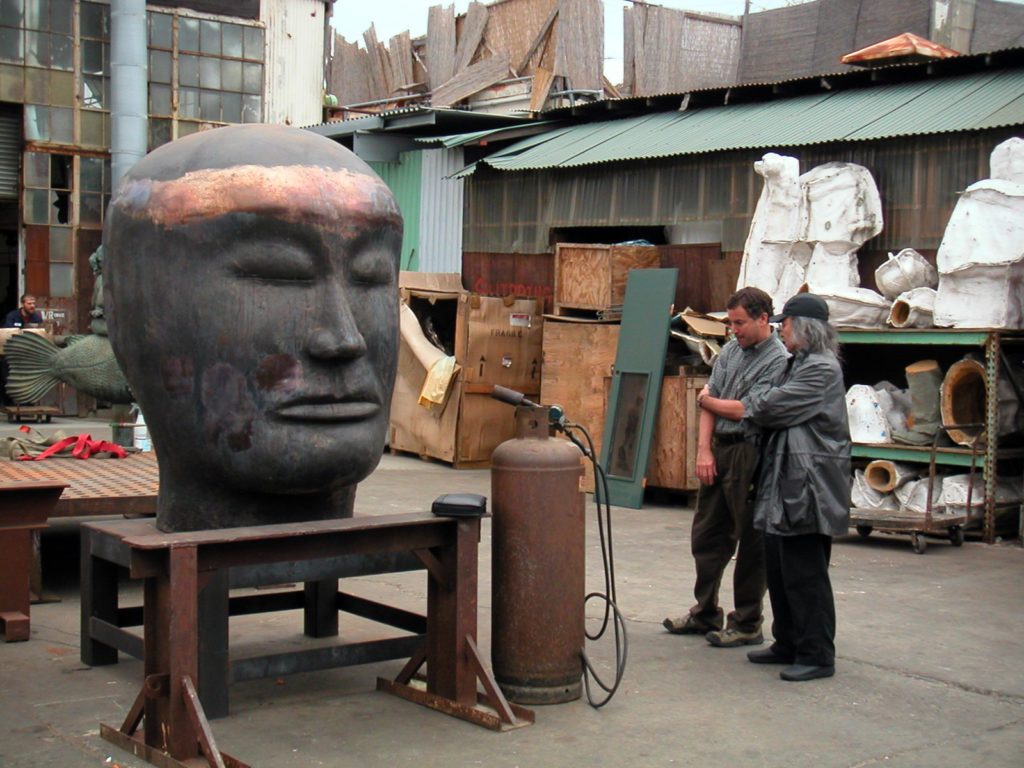
Jun Kaneko at Artworks Foundry in Berkeley, CA. Photo: Jun Kaneko Studio
2003
January. Kaneko goes to Japan for meetings with Mr. Kasahara and the National Museum of Art, Osaka, and The Museum of Modern Ceramic Art, Gifu, to plan exhibitions for 2006.
March. Architect Mark Mack begins to develop architectural plans for KANEKO. Jun Kaneko marries Ree Schonlau. The Kanekos meet with Joan Desens, General Director of Opera Omaha. A discussion between Ree and Joan leads to the idea of Jun collaborating with the Opera to create designs for Puccini’s Madama Butterfly.
May. Rudy Autio and Ken Little work on new pieces at Kaneko’s studio.
June. Kaneko travels throughout Europe and attends the Venice Biennale. He opens dual exhibitions at the museum of Applied Arts and Gallerie Bandstrup for the Oslo International Ceramics Symposium, for which he and Tony Cragg are the keynote speakers.
August. Kaneko works in Maine at Acadia Summer Art Program (ASAP). He begins research and conceptual drawing for the production of Madama Butterfly.
November. Kaneko goes to Philadelphia for a meeting with Fabric Workshop about creating textiles for costumes for a production of Madama Butterfly.
December. A public art commission is installed in Pasadena. In his Omaha studio, Kaneko has his first meeting with the director of Madama Butterfly, Leslie Swackhammer.
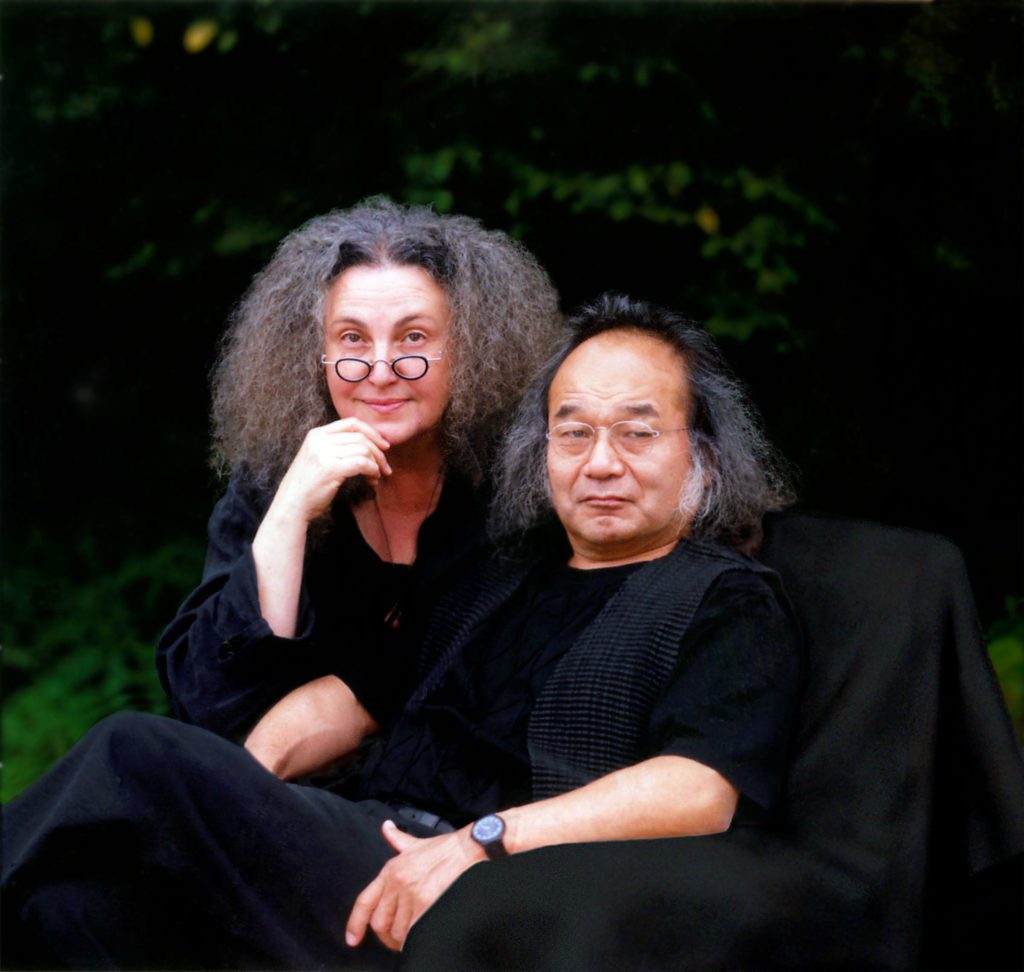
Ree and Jun Kaneko. Photo: Courtesy of Ree & Jun Kaneko.
2004
January. A public art commission is installed at the San Jose Repertory Theater. Kaneko travels to his Hawaii studio to work on the designs for Madama Butterfly.
February. Kaneko goes to Japan to plan museum exhibitions scheduled for 2006.
March. Kaneko holds meetings with the 13 lead members of Madama Butterfly production.
April. He works on a new series of glass pieces at Bullseye Glass Research and Development. He then travels to New York City to attend the conference on Madama Butterfly.
May. Kaneko opens an exhibition for the Grand Opening of the Rochester Art Center in Minnesota. He meets with Mark Mack in Omaha and a local architectural firm on KANEKO blueprints.
June. Kaneko visits Mission Clay in Pittsburg, Kansas to consider doing a large-scale sculpture project there.
July. He works through August on Madama Butterfly at a studio space provided by Kippy Boulton Stroud at Acadia Summer Art Program (ASAP) in Maine.
September. Kaneko and Mark Mack lecture on the collaborative process at the UNL Architecture Department. He attends the International Sculpture Center Spiral Jetty conference.
November. He travels to Mexico with Robert and Karen Duncan to consult on the design for a new studio site.
December. Kaneko attends a production of Madama Butterfly in Miami. He returns to Mission Clay in Pittsburg with project lead assistant Conrad Snider for a project planning meeting with the factory manager.
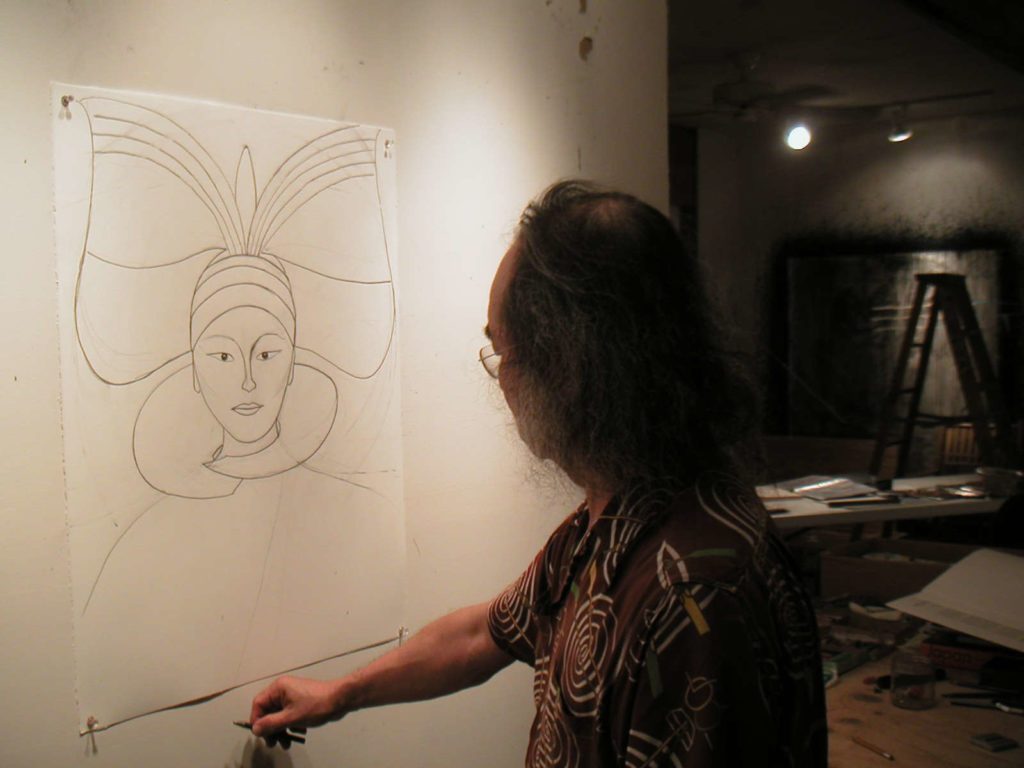
Jun Kaneko drawing character designs for Madame Butterfly. Photo: Jun Kaneko Studio.
2005
January. Kaneko travels to Phoenix for the Grand Opening of Bentley Gallery. He continues on to Puerto Vallarta to select architects for the construction of the studios, and on his Madama Butterfly costume designs. The textiles for these were produced over four months at the Fabric Workshop in Philadelphia.
February. Kaneko travels to New York for the opening of Christo’s Gates in Central Park. He finalizes his plans to build large scale sculptures at Mission Clay Pittsburg in Kansas City.
March. Kaneko travels to Japan and Korea. He is a judge at the International Ceramic show in Mino. He meets with the director of the Gifu Museum and Kasahara to plan for his 2006 show. The first major presentation of Jun’s ideas for Madama Butterfly occurs at his Omaha studio.
April. The Mission Clay Pittsburg Project begins on April 5. After years of planning and discussions with Bryan Vansell of Mission Clay Products, Kaneko and his team set out on an ambitious, large-scale ceramic project that involves using Vansell’s largest beehive kilns. Materials including forklifts, industrial clay mixers and forty-five tons of clay travel from Omaha to the Mission Clay Products factory in Pittsburg, Kansas in three semi-trucks. Kaneko and his team will live in Pittsburg over the next two years to complete this project. It will conclude in September 2007. Jun remains in Pittsburg, KA through May, working on large scale Heads and Dangos, as well as Madama Butterfly projections.
May. A Smithsonian interview is recorded at the studio. Fabrication of Heads ends May 21.
June. The Kanekos travel to Europe for Art Basel. They meet with Ed Rusha and visit the Jean Tingly Museum. Mark Mack joins them as they travel to Zurich, Innsbruck, Vienna, Berlin, Amsterdam, and London.
July. Jun Kaneko is Awarded an Honorary Doctorate from the Royal College of Art in London. He returns to Pittsburg and construction of Dangos continues. Final costume designs for Madama Butterfly are due. He works on Madama Butterfly textiles at the Fabric Workshop in Philadelphia. This process is completed at the end of October.
August. Kaneko works in Maine, then returns to Pittsburg. The first fabrication session ends on August 17. He meets with costume designers in Salt Lake City.
September. Madama Butterfly costume construction begins. A session at Bullseye Glass Studio begins on the 20th. Kaneko begins work on projections for Madama Butterfly.
October. Kaneko returns to Omaha for a KANEKO creative board meeting. Jun Kaneko opens at the Salt Lake Art Center, Salt Lake City, UT.
November. Kaneko begins designing a book on the Madama Butterfly creative process and prints The Butterfly Suite. He lectures at the Japanese American Museum in Los Angeles, CA. He then visits his Salt Lake City exhibition and checks on costume fabrication. Leslie Swackhamer visits Omaha.
December. Arthur Danto writes a catalogue essay for Kaneko’s upcoming show at the Gifu Museum in Japan. Fabrication starts again at Mission Clay Pittsburg. Work continues on Madama Butterfly projections.
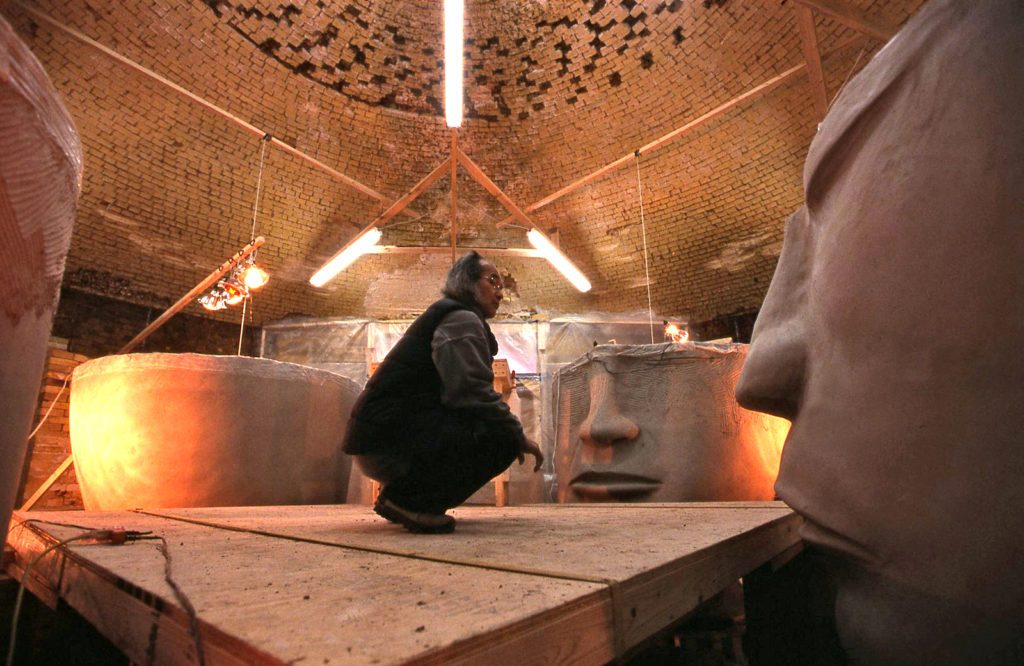
Jun Kaneko in the kiln sculpting heads at Mission Clay Products in Pittsburg, KS. Photo: Takashi Hatakeyama.
2006
January. Kaneko travels to Mexico for a drawing session via Bullseye Glass Studio in Portland. The first works at Mission Clay Pittsburg are drying.
February. Kaneko attends an exhibition opening in Phoenix at Bentley Projects, and lectures at the Phoenix Museum of Art. He travels to Hawai’i for the opening of Tropical Reflection: Drawings, Paintings and Sculpture by Jun Kaneko at The Contemporary Museum at First Hawaiian Center, Honolulu. Installation of Madama Butterfly sets begins; singers arrive in Omaha for rehearsals and costume fittings. Jun Kaneko: Madama Butterfly opens at the Joslyn Art Museum, Omaha, NE. In conjunction with Smith Kramer Fine Arts, the Kaneko Studio curates a touring exhibition of Kaneko’s work that will travel for five years. Running through 2011, the show will travel to the following venues: Knoxville Museum of Art, World’s Fair Park, Knoxville, Tennessee; Montgomery Museum of Fine Arts, Montgomery, Alabama; Museum of Texas Tech University, Lubbock, Texas; Boise Art Museum, Boise, Idaho; The Arts Center, St. Petersburg, Florida; San Jose Museum of Art, San Jose, California; Alden B. Dow Museum of Science and Art Midland Center for the Arts, Midland, Michigan; The Arkansas Arts Center, Little Rock, Arkansas; Mobile Museum of Art, Mobile, Alabama; The Morikami Museum and Japanese Gardens, Delray Beach, Florida; Museum of Arts and Sciences, Macon, Georgia; Reading Public Museum & Art Gallery, Reading, Pennsylvania; and the Crisp Museum, Southeast Missouri State University, Cape Girardeau, Missouri.
March. Jun Kaneko: Beyond Butterfly opens at the Bemis Center for Contemporary Arts, Omaha, NE. Madama Butterfly premiers at Opera Omaha.
April. Kaneko works at Bullseye Glass Studio. He travels to Japan with the whole family for the opening of Jun Kaneko at the Museum of Modern Ceramic Art, Gifu, Japan.
May. Kaneko is Awarded an Honorary Degree of Human Letters Degree by the University of Nebraska. He is selected with Ree as a new member of The Knights of Ak-Sar-Ben’s Court of Honor. The Kanekos travel to Hawai’i for the International Culture Summit in Honolulu. Jun Kaneko submits four public art proposals: Mid-America Center in Council Bluffs, IA; Bartle Hall in Kansas City, MO; Denver Airport, CO; and a second project, Front Line, at The University of Connecticut, Burton Family Football Complex, Storrs, CT.
June. A music performance by Hal Foster, with backgrounds by Kaneko, shows at the BLUEBARN Theater. Kaneko’s exhibition opens at Bullseye Glass. Bisque firing begins at Mission Clay Pittsburg.
July. The Kanekos travel to Marfa, TX with Terry and Jo Harvey Allen. The bisque fire in Pittsburg is ongoing. They travel to Japan for the installation and opening of Jun Kaneko at The National Museum of Art, Osaka, Japan. Work is also installed at the Grand Hyatt in Tokyo.
August. Kaneko teaches a workshop at Anderson Ranch. The Mission Clay kilns are in the cooling stage. Kaneko is awarded a contract by the Kansas City Council as part of the city’s One Percent for Art program to create new public art at the Bartle Hall ballroom expansion. His outdoor installation design, Water Plaza, includes seven ceramic sculptures — two large-scale heads and five spotted dangos.
September. Unloading of bisque kilns at Mission Clay Pittsburg begins. Jun Kaneko: Drawings and Prints opens at The Museum of Nebraska Art, Kearney, NE.
October. Madame Butterfly opens at Dayton Opera, as does Jun Kaneko: Madame Butterfly at the Dayton Visual Arts Center, Dayton, OH. Kaneko begins glazing Bartle Hall pieces. The installation at the Dr. C.C. & Mabel Criss Library, University of Nebraska Omaha is unveiled and dedicated. At the dedication ceremony of the Dr. Guinter Kahn Addition at University of Nebraska Omaha’s Criss Library, a 2,300-pound (about 1 metric ton) Head that Kaneko was commissioned to produce for the space is unveiled as the centerpiece of the addition’s top level.
The Kanekos are honored at the Knights of Ak-Sar-Ben Ball. Kaneko lectures at the Phoenix Museum of Art.
November. Work on Bartle Hall site begins. Kaneko glazes a series of Heads and Dangos at his Omaha studio.
December. Kaneko visits the site of Temple Har Shalom in Park City, UT, where he will be commissioned to design the art glass windows. He then proceeds to Portland to work at Bullseye. Kaneko works at Mission Clay Pittsburg, glazing a first set of Dangos, and on a large-scale painting for Bartle Hall.
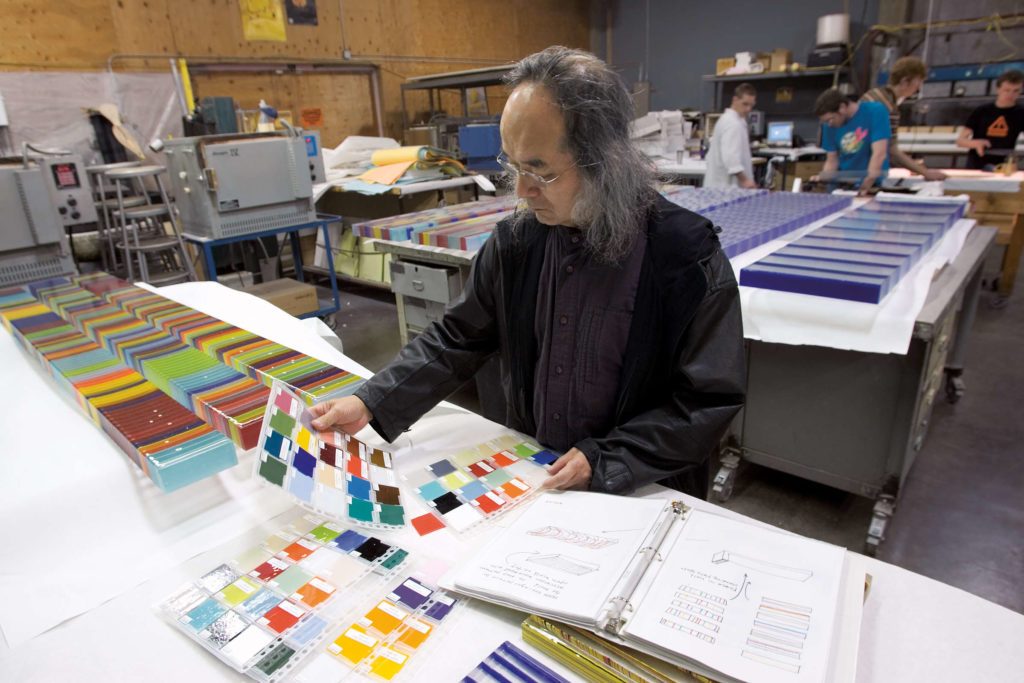
Jun Kaneko at Bullseye Glass studio. Bullseye Glass Co.
2007
January. Kaneko works in Puerto Vallarta on designs related to Madama Butterfly, for a series of bags, and for his new set of glass chunks. Mission Clay Pittsburg pieces are being sandblasted. Kaneko lectures at the Dallas Museum.
February. Work for Bartle Hall, Kansas City, MO, is finalized. Kaneko spends the month glazing sixteen Dangos at Mission Clay Pittsburg. He signs a contract for a large installation at Mid America Center in Council Bluffs, IA.
March. The Kanekos travel to Honolulu for Jun to give a lecture on the Aquarium commission and his Madama Butterfly design work. Madama Butterfly opens at Hawaii Opera. They visit with Susan Peterson and go to Lihue and Maui. Robert Driver, the General and Artistic Director of The Opera Company of Philadelphia (OCP) sees Madama Butterfly in Honolulu. Driver shares the production book of Madama Butterfly with OCP’s Music Director, Corrado Rovaris and Managing Director, David Devan. After meeting with the Kanekos in Hawaii, Driver invites Jun to design OCP’s upcoming production of Fidelio.
Kaneko’s solo exhibition New Glass opens at the Bullseye Gallery in Portland, Oregon. His third all-glass exhibit at Bullseye, New Glass showcased 20,000 pounds (9 metric tons) of raw glass, 40 cast-glass slabs, and a 42-foot-long (12.8m) spiraling wall of glass threads.
July. Driver and OCP’s Director of Design and Technology, Boyd Ostroff and Costume Director, Richard St. Clair visit the Kanekos in their home and studios in Omaha to begin their collaboration on Fidelio.
April. Kaneko spends the month glazing at Mission Clay Pittsburg. The project at Bartle Hall is unveiled to the public.
May-August. Kaneko travels to San Francisco to work on bronze heads at Artworks Foundry, then to Philadelphia to oversee Fidelio set fabrication. He glazes the last three nine-and-a-half foot Dangos at Mission Clay Pittsburg, and begins the fabrication of eight foot Dangos. Jun will work at Mission Clay Pittsburg through September. On July 13, he turns 65. Jun Kaneko opens in August at Knoxville Museum of Art, Knoxville, TN.
September. A pair of Heads is installed at the Four Seasons Resorts in Maui. A party is thrown at Mission Clay Pittsburg on September 29th to celebrate the successful firing of the glazed pieces.
October. Kaneko travels to Portland to work at Bullseye. His team loads the Mission Clay project pieces into four semi-trucks and returns to Omaha.
November. Kaneko works on Fidelio costume designs and stage sets through December. He is also glazing at his studio in Omaha.
December. Jun Kaneko opens at The Museum of Texas Tech University, Lubbock.
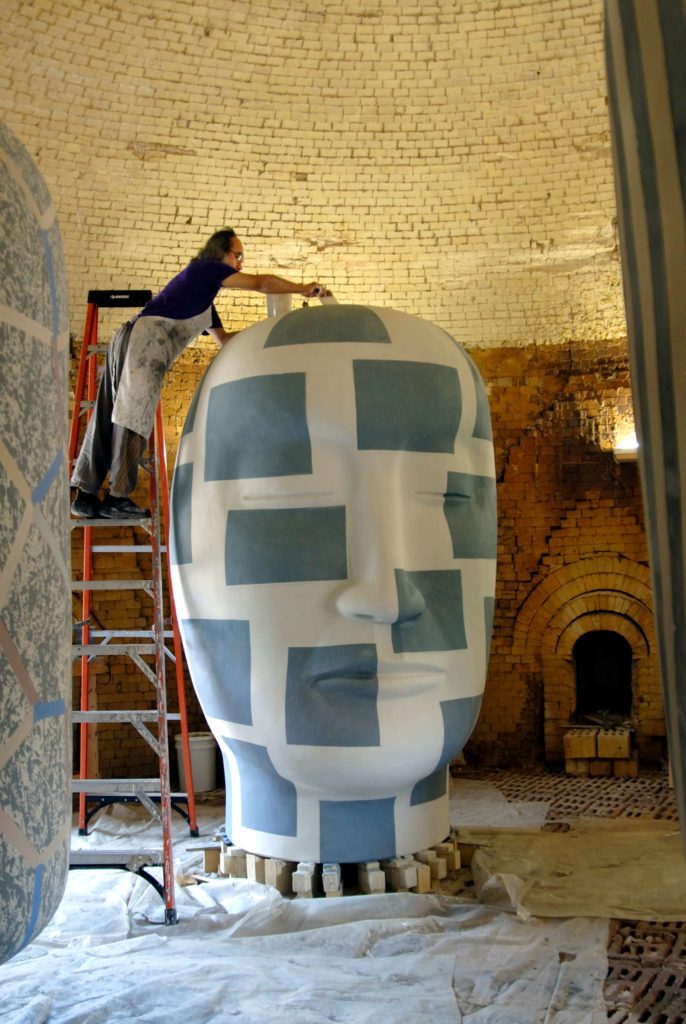
Jun Kaneko glazing a Head sculpture at Mission Clay Products in Pittsburg. Photo: Takashi Hatakeyama,
2008
January. Fabrication of a tile wall for the Mid-America Center installation begins. Kaneko works in his Mexico studio through February on the final designs for his production of Fidelio.
March. Kaneko works on pieces for the Mid-America Center, travels to a series of potential sites for public art projects, visits Albert Paley’s studio in Des Moines, and works in his Omaha studio on glazes and on Fidelio projections.
April. Glass windows are installed at Temple Har Shalom, Park City, UT. Mark Mack visits the studio and KANEKO. Jun Kaneko works in Omaha on the Mid-America Center project.
May. Kaneko receives an honorary degree from Massachusetts College of Art & Design, Boston. Fidelio design is due. Jun Kaneko Studio prepares for the Mid-America Center installation. Jun spends the month glazing at the Jones Street studio.
June. Kaneko on Park Avenue opens in New York City. Three nine-foot-tall Heads remain on view until November. Paving is installed at the Mid-America Center and installation of sculptures begins. The Temple Har Shalom windows are unveiled and a dedication is held.
July. Fidelio sets start being built in Philadelphia. Construction on the Kanekos’ new loft residence comes to an end.
August. The Kanekos go to Maine for the Acadia Summer Arts Program (ASAP/Kamp Kippy).
September. Jun Kaneko opens at Montgomery Museum of Fine Arts, Montgomery, AL.
Kaneko gives a lecture at the Museum. The Mid-America Center construction continues. Rehearsals for Fidelio begin at Opera Philadelphia.
October. The Kanekos attend the opening of Madam Butterfly at Atlanta Opera. They travel to Philadelphia to attend the opening night of Fidelio. Jun gives a presentation on his Des Moines Riverwalk proposal.
November. The Park Avenue exhibition ends. Sculptures are installed at the Mid-America Center. Jun Kaneko opens at Boise Art Museum, ID. Madama Butterfly is performed at the Madison Opera, WI.
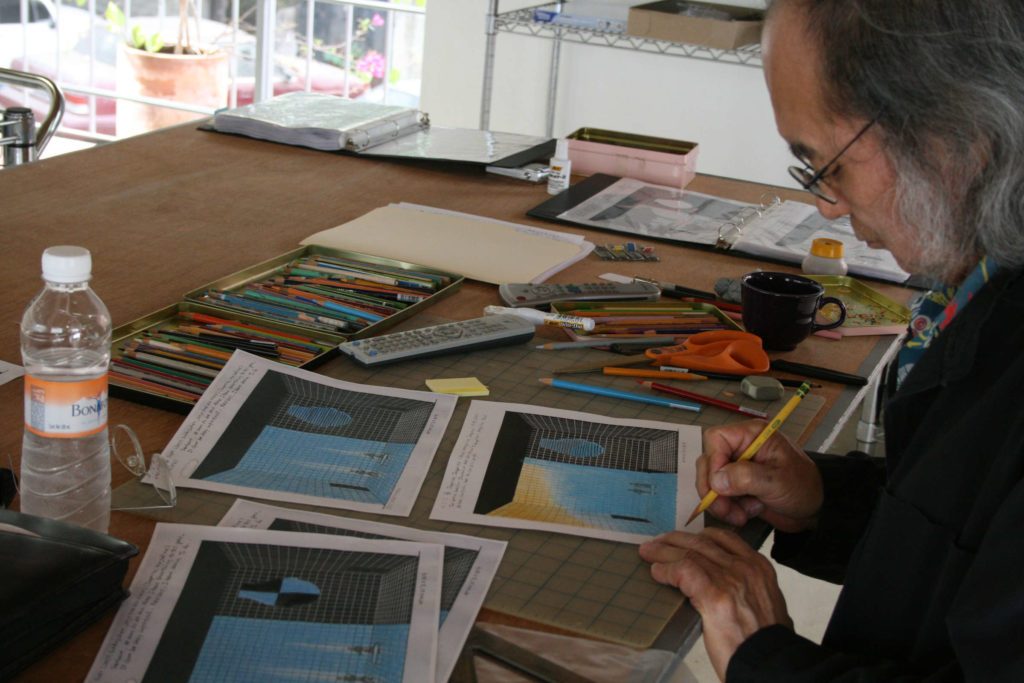
Jun Kaneko working on Fidelio scene designs. Photo: Ree Kaneko.
2009
January. Kaneko starts a new series of paintings at the Jones Street studio. This painting session will last through February.
February. An exhibition opens at San Jose Museum, CA. KANEKO library is opened to the public. Jun continues to work in his painting studio.
March. Crosscurrents: Jun Kaneko & David Kuraoka opens at the Maui Arts and Culture Center, Kahului, HI. Susan Peterson passes away on March 26.
April. Kaneko works with Vancouver Opera on their presentation of Madama Butterfly. He finalizes the installation at The Michael F. Sorrell Center for Health Science Education at the University of Nebraska Medical Center in Omaha. He then flies to Chicago for SOFA and the International Sculpture Center reception.
May. Jun Kaneko opens at the Arkansas Art Center in Little Rock. Kaneko works on glazing tiles for an installation in Portland. He lectures at the Leaky Foundation.
June. Play’s the Thing: The Paintings and Objects of Jun Kaneko opens at the Sheldon Art Museum in Lincoln, NE. The Joslyn Museum in Omaha unveils its new sculpture garden. Works at Walla Walla Foundry.
July. A large Head building session starts. Two exhibitions open in Tokyo: Kaneko in Tokyo in the Middle Town Garden, and Kaneko in Tokyo at the Shinwa Art Museum. Jun travels to Tokyo, Osaka, Shigaraki, and Nagoya.
August. Kaneko travels to Walla Walla to continue his work on the bronze heads. He returns to Omaha to work in the painting studio. Jim Dine visits the studio.
September. Four exhibitions of Kaneko’s work open in Philadelphia, at Philadelphia Museum of Art, the Kimmel Center, City Hall, and Locks Gallery, in conjunction with the upcoming performance of Madama Butterfly at the Opera Company of Philadelphia. Nick Cave visits the studio. Mobile Museum exhibition opens in Alabama. The Kanekos travel to Santa Fe.
October. The Kanekos travel to Philadelphia for final rehearsals of Madama Butterfly and opening night at Opera Philadelphia.
November. The Kanekos travel to Kyoto. Jun teaches a five day workshop at Seika University in Kyoto, and gives a series of lectures to the students on his building process and opera designs. They then travel to Nagoya.
December. Jun Kaneko: Ceramic Sculpture, Paintings, and Drawings opens at the Morikami Museum and Japanese Gardens. The International Ceramic Invitational opens at the Yingge Museum in Taiwan. Jun’s father Yutaka Kaneko passes away on December 21. Jun travels to Nagoya.
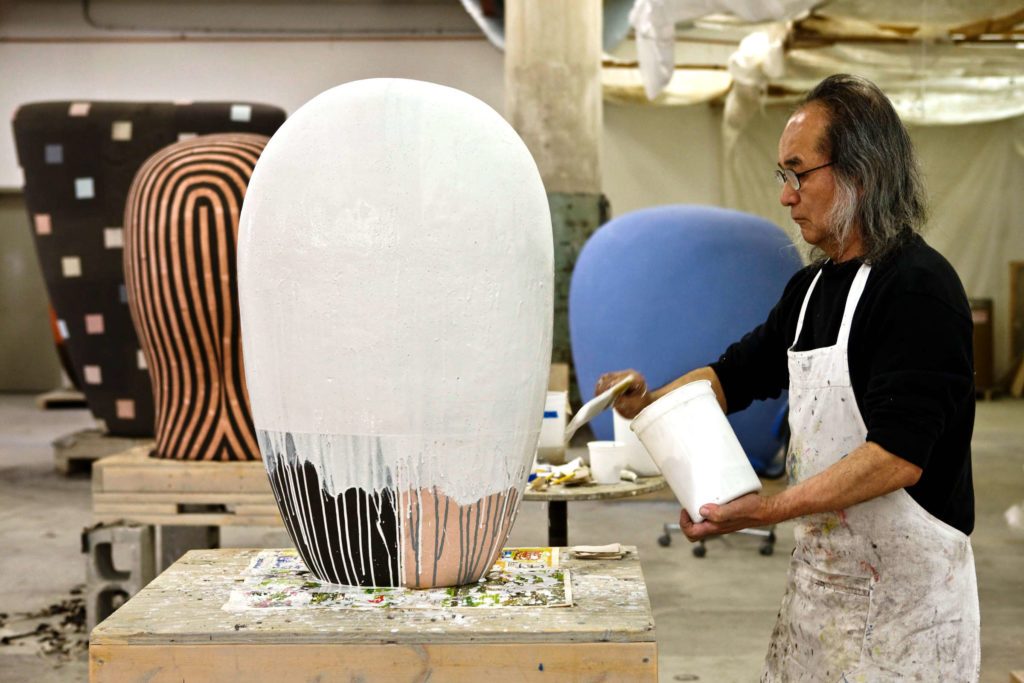
Jun Kaneko in his studio glazing a Dango. Photo: Takashi Hatakeyama.
2010
January. Kaneko joins the Artist Advisory Board at the Fabric Workshop, Philadelphia, PA. The Racine Museum exhibition closes. Kaneko travels to Puerto Vallarta and sets up a painting studio there. Mark Mack and Wally Cunningham visit him there, among others. He will work there through February.
March. Kaneko travels to Phoenix to lecture at ASU, then to New York for the William Kentdrige show. The rest of the month is spent on early conceptual development for his next opera, The Magic Flute, and for a potential project in Doha.
April. Kaneko attends NCECA in Philadelphia, then travels to the Netherlands to visit Den Bosh, then to London for the International Sculpture Center conference. He goes to Qatar to visit a site in Doha, then on to Berlin and Frankfurt.
May. Construction begins on new studio spaces in Omaha on S. 20th Street. Kaneko goes to Oregon to work at Walla Walla foundry. He travels to Vancouver at the end of the month to attend Opera Vancouver’s production of Madama Butterfly.
June. Kaneko begins the conceptual development stage for The Magic Flute and continues working on the Doha project. He visits Misha Gordon and Terry Allen. At this time, his studio starts to move into the new space on S. 20th Street. Planning begins for exhibition at Lauritzen Gardens in Omaha. Jun Kaneko opens at the Reading Public Museum, Reading, PA
July. Kaneko spends the month working in Omaha. His mother, Toyoko Kaneko, comes to visit. An exhibition opens at the Virginia Museum of Fine Arts.
August. Kaneko travels to Walla Walla to work at the Foundry. Fletcher Benton’s show opens at KANEKO. Albert Paley visits the studio.
September. Kaneko lectures at the Virginia Art Museum in Richmond. An exhibition opens at the Rosemary Berkel and Harry L. Crisp II Museum in Cape Girardeau, MO. A kiln room is constructed at the 20th Street Studio. Building begins on 10-foot sculptures and continues through October.
November: The Kanekos travel to Doha, and then to Germany to visit Derix Glassstudios. Jun begins working on the design of The Magic Flute full time. An exhibition opens at the Ohr-O’Keefe Museum in Biloxi, MS. Kaneko meets Frank Gehry at a gala opening. He lectures at the Crisp Museum in Cape Girardeau. His complete draft of The Magic Flute stage set is finished.
December. Kaneko attends Art Basel Miami. He begins the costume designs for The Magic Flute. The Kanekos spend December in Sicily with friends.
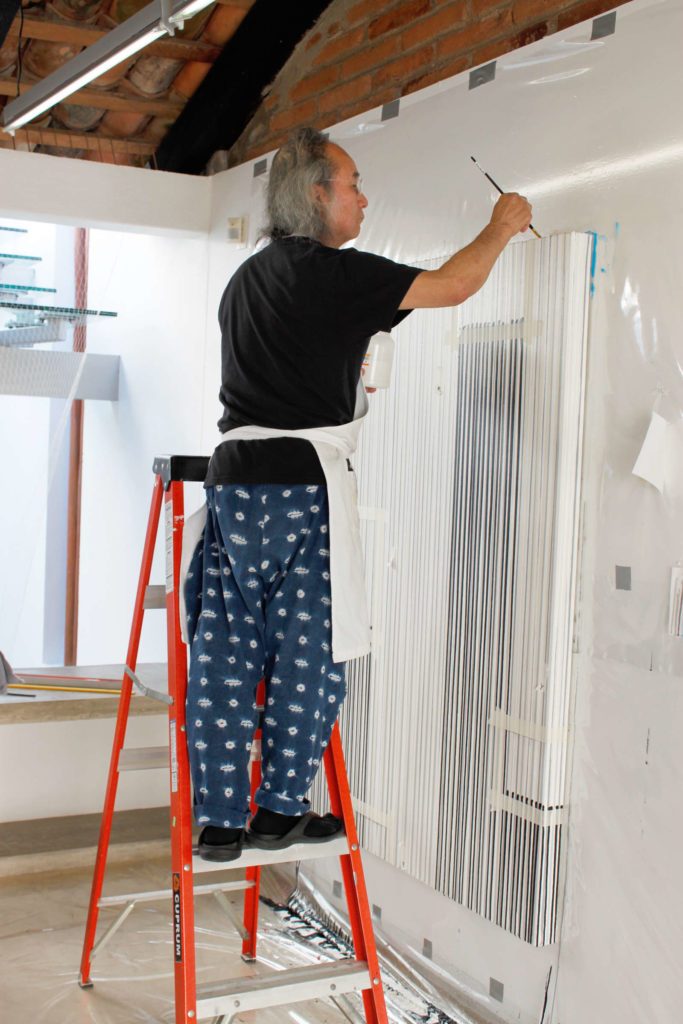
Jun Kaneko painting at Aguacate studio in Puerto Vallarta. Photo: Ree Kaneko.
2011
January. The Kanekos leave Sicily to visit Rome and Monaco. Jun visits the project site in Doha, where Ree and Susan Schonlau later join him. The Kankos then travel to Puerto Vallarta to work on The Magic Flute stage and costume designs until the end of February.
March. Kaneko travels to Washington D.C to receive the 2011 Smithsonian Masters of Ceramic Award. He gives a presentation at Renwick Gallery. Madama Butterfly rehearsals begin at Opera Omaha. Kaneko attends NCECA in Tampa, FL. The Madame Butterfly exhibition opens at the Joslyn Museum, Omaha. He gives a presentation on the opera at KANEKO. Construction is underway on a massive new kiln at the S. 20th Street studio. Jun Kaneko Ceramics opens at the Sonoma County Museum, Santa Rosa, CA.
April. Kaneko travels to San Francisco to fundraise for The Magic Flute. Final rehearsals for Madama Butterfly take place with the whole opera company in Omaha. Kanek works at his Jones Street studio. The Outside Kaneko exhibition opens at Lauritzen Gardens. Ree Kaneko attends the Frank Stella lifetime achievement award ceremony.
May. Jun Kaneko travels to Walla Walla to work at the Foundry. He finalizes The Magic Flute projections.
June. The Gardiner Museum exhibition opens. Kaneko meets with the costume department at the San Francisco Opera. He gives the keynote address at the Archie Bray Foundation’s 60th anniversary celebration.
July. San Francisco Opera conducts projection tests. Kaneko attends Paul Soldner’s memorial at Anderson Ranch. Construction of the S. 20th Street studio is completed.
August. The Lincoln Civic Plaza project is approved. Works for a Shanghai installation leave Omaha.
September. An exhibition opens at Sherry Leedy Gallery in Kansas City, MO. The Gardiner Museum exhibition closes. Lucas Cowan travels to Omaha to plan the Millennium Park exhibition.
October. The KANEKO hosts a Philip Glass performance. Kaneko attends Jim Eskin’s memorial in Iowa City. He attends the opening of a show at Duane Reed Gallery, St Louis, MO. He travels to Artworks Foundry in San Francisco.
November. Kaneko meets Lucas Cowen in Chicago to plan the Millennium Park exhibition, and to attend SOFA. Large scale building takes place at the studio. He travels to Japan to teach a five day workshop at Seika University, Kyoto, then visits Osaka and Nagoya.
December. Jun Kaneko – In the Round opens at the Mint Museum, Charlotte, NC. Jun finalizes the design of his Tanuki.

Jun Kaneko designing Tanuki forms. Photo: Jun Kaneko Studio.

Jun Kaneko working on book layouts for The Magic Flute. Photo: Jun Kaneko Studio.
2012
January. Kaneko travels to Charlotte, NC for a reception at the Mint Museum and for the opening night of Madama Butterfly at Opera Carolina. He attends Palm Beach Art Fair as the honored speaker. Large scale Dango and Head fabrication continues at the S. 20th St. studio. A second Tanuki build begins. Framework for a large kiln at the S. 20th St. studio is erected.
February. Jun starts glazing his first series of clay pipes at Mission Clay Pittsburg. Jun gives a lecture at the Gardiner Museum in Toronto, Canada. Mark Mack meets Jun and Ree in Puerto Vallarta, Mexico.
March. The Kanekos travel to San Francisco to attend the final revision to The Magic Flute projections and to review the costumes and makeup. They attend an opening of his latest work at Imago Gallery. Wally Cunningham visits the Kanekos in Omaha. A large Tanuki form is sculpted in Mexico. Mark Mack travels to Omaha.
April. Fabrication begins on large scale work at the S. 20th St. studio. A Japanese consul travels to Omaha to visit the studio. The first cast tanuki is finished at the studio in Cuernavaca.
May. The Kanekos travel to San Francisco for the final Magic Flute rehearsals. Installation of stage props and lighting begins.
June. The Kanekos travel to San Francisco and attend the opening night of The Magic Flute as well as the opening of his exhibition at the Rena Bransten Gallery. Toyoko Kaneko flies in from Japan. Jun visits Artworks Foundry in Berkeley to oversee the casting of a series of Heads.
July. Kaneko starts glazing the Tanuki. The Kanekos travel to San Francisco for the final performance of The Magic Flute.
August. Kaneko starts working on his Mission Clay pipe project and works on glazing tiles for a project in D.C. He travels to Cuernavaca to work at Juan Sanchez de Dios’ raku studio. The first series of raku Tanuki are fired at this time. Anton Reijnders visits Jun in Omaha.
September. The Kanekos travel to Frankfurt to meet with Derix Glass about creating an illuminated art glass tower for the Lincoln Civic Plaza project. They also visit Berlin. They then travel to Osaka and Nagoya. Jun is recognized as Regis Master by the Northern Clay Center in Minneapolis.
October. The Kanekos travel to Chicago to discuss plans for the Millennium Park exhibition. They travel to Charlotte to attend the Opera performance of The Magic Flute. The Tanuki are glaze fired. Five Dangos are unveiled at the Principal Riverwalk, Des Moines, IA.
November. Jason Hovey arrives as new studio manager. Bill Arning travels to Omaha to meet Jun Kaneko. Work on Millennium Park tanuki continues. Jun lectures at KANEKO on the making of The Magic Flute. A permanent installation of large scale sculptures is completed at the Shanghai Financial Center.
December. Kaneko attends Miami Basel. The Gardiner Museum tours the studio. Tests on the newest large kiln at S. 20th St. are successful.
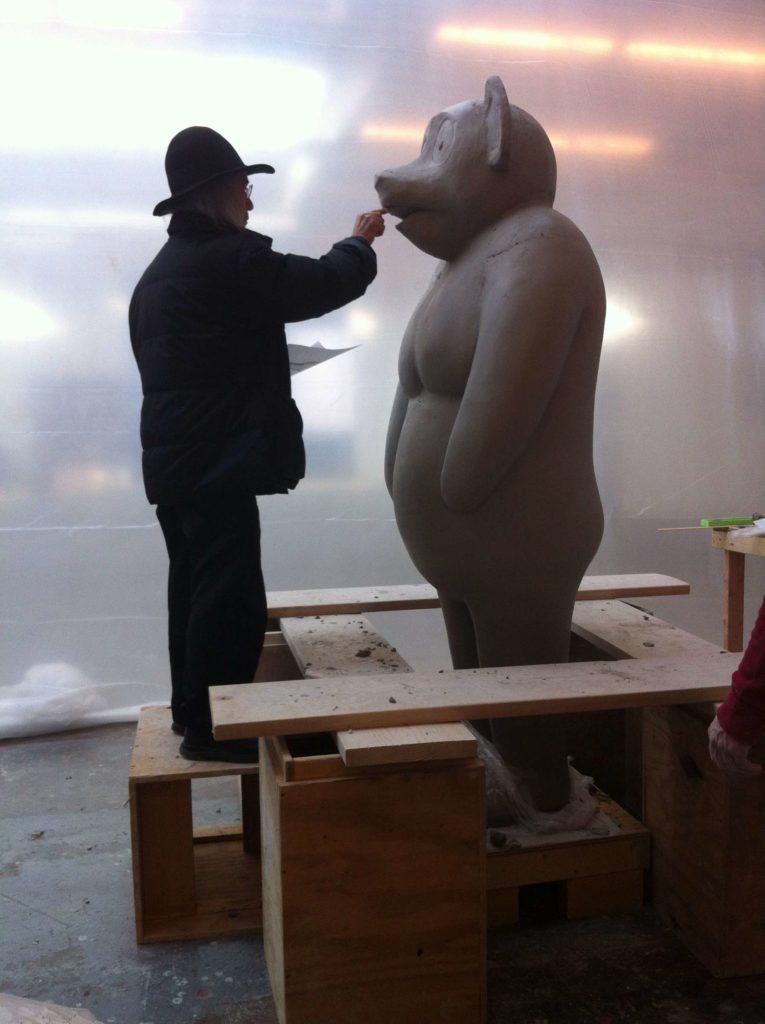
Jun Kaneko sculpting a Tanuki’s face. Photo: Ree Kaneko.
2013
January. The Kanekos travel to Cuernavaca for the second work session on the raku Tanuki and Wall Slab series. They visit La Taller Studio in Mexico. The glazed hand-built Tanuki exit the Jones St. studio kiln. The Magic Flute is performed at Opera Carolina.
February. The first set of raku Tanuki arrive in Omaha. The Magic Flute is performed at Opera Omaha. A second set of hand-built Tanuki is created at the S. 20th St. studio. The KANEKO gallery renovations begin.
April. Legends, Myths and Truths: Jun Kaneko, an exhibition of Tanuki and Dangos, opens at the Boeing Galleries, Millennium Park, Chicago. Terry Allen and Jo Harvey visit the studio. Patrick Siler’s work is shown in the renovated galleries at KANEKO.
May. Kaneko travels to New York to work on the Sing for Hope project. He visits the Gutai retrospective at the Guggenheim. The first set of raku Wall Slabs arrive in Omaha.
June. Another set of raku Tanuki arrive at the studio.
July. A third Tanuki building session begins at the S. 20th St. studio. Kaneko glazes the first set of large scale dangos for the new kiln at S. 20th St. studio.
August. New two foot bronze heads arrive from Artworks Foundry. Kaneko travels to Cuernavaca to work on a second raku session. The new kiln at S. 20th St. studio is opened.
September. Kaneko glazes the second set of hand-built Tanuki. Adam Weinberg, the director of the Whitney, visits the studio. Kaneko’s Pittsburg Dangos and Parallel Sound are installed at KANEKO.
October. Kaneko travels to New York to visit Boaz Vaadia and see the Albert Pailey installation on Park Avenue. He visits the New Museum to see the Chris Burden retrospective. He lectures about his The Magic Flute production at the Nelson-Atkins in Kansas City. The opera is performed at the Kansas City Lyric Opera. Installation begins on a glass wall at the Des Moines Riverwalk in Iowa.
November. The Millennium Park exhibition closes. A solo exhibition opens at Sherry Leedy. Seasons of Sculpture VI opens in Sarasota. Kaneko travels to Japan to visit family and friends. Two specialists from Artworks Foundry travel to Omaha to make casts of ceramic Heads (which will later be installed at the Bisha Hotel in Toronto) at the S. 20th St. studio.
December. Kaneko’s mother passes away. He works on additional costume designs for the San Francisco Opera’s production of The Magic Flute. Another Tanuki glazing session begins.
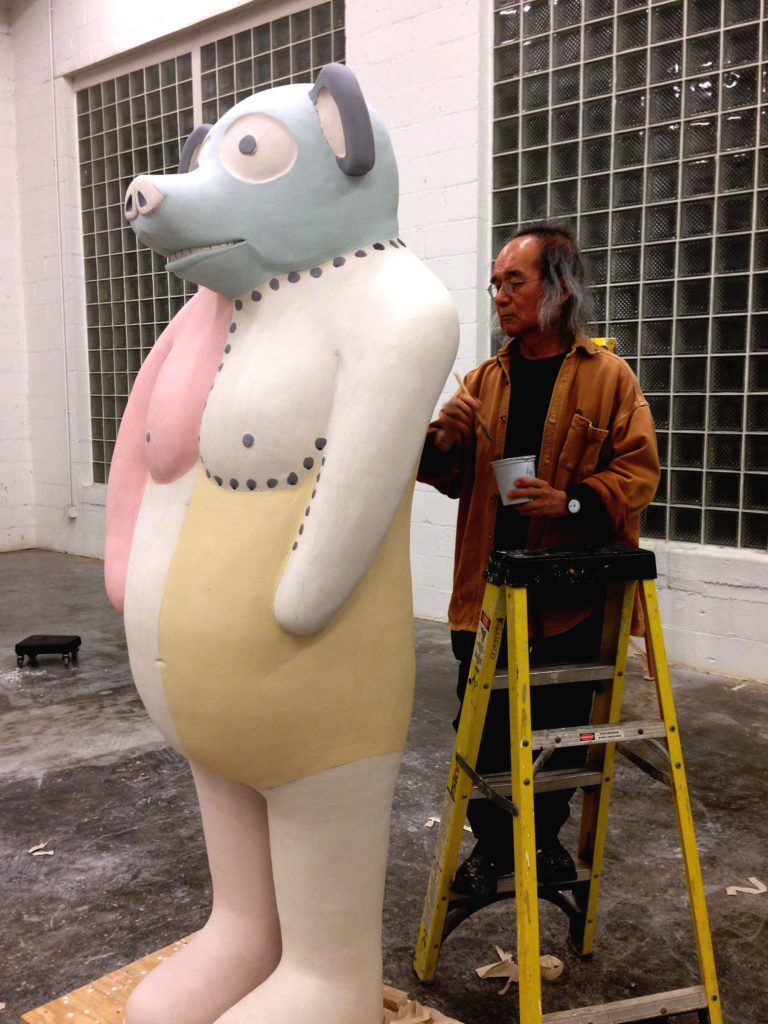
Jun Kaneko applying polka dot pattern to a Tanuki. Photo: Ree Kaneko.
2014
January. Kaneko travels to Japan for his mother’s funeral. He visits Goro Suzuki’s studio in Toyota City. The exhibition of Fremont Dangos and Parallel Sound at KANEKO closes. He finishes glazing the third set of Tanuki.
February. Kaneko travels to Mexico to glaze a series of raku Tanuki and Wall Slabs. He works on new costumes for San Francisco’s new production of Madama Butterfly, and completes the glazing of a new set of Heads for an installation in Toronto. Construction begins on the Civic Plaza installation in Lincoln.
March. Kaneko Travels to Phoenix, AZ, to visit the Frank Lloyd Wright house and to begin work at Building Products Co. on a series of clay sewer pipes that will become his Column forms. The glass wall, Expansion, is unveiled at the Des Moines Riverwalk Pump House.
April. Kaneko glazes second set of a new style of Heads. He travels to Washington D.C. to supervise the costume fittings and rehearsals of The Magic Flute at the Kennedy Center. He gives a lecture on the creative and design process, and oversees the installation of his works in the Hall of Nations. A solo Exhibition at Locks Gallery in Philadelphia opens.
May. The Kanekos attend the opening night of The Magic Flute at the Kennedy Center. An installation of five Dangos and a Tile Wall at Eli Whitney Technical college is completed. Mark Mack visits Omaha. Small raku Tanuki arrive from Mexico. A second set of large scale Dangos are fired at the S. 20th St. studio. Kaneko travels to San Francisco to review costumes for Madama Butterfly and attend final rehearsals. Seasons of Sculpture VII in Sarasota, FL closes.
June. A permanent installation of Tanuki at the Henry Doorly Zoo in Omaha is unveiled. Goro Suzuki travels to Omaha and works at the Jones Street studio. Kaneko travels to San Francisco for opening night of Madama Butterfly at the San Francisco Opera. Owing to the prominent glass tower in Kaneko’s installation design, Civic Plaza in Lincoln is renamed, “Tower Square.” Kaneko visits Artworks Foundry to supervise work on a new series of Heads.
July. Kaneko glazes a series of small constructions for the show at Sokyo Gallery. He travels to Cuernavaca to work on raku Tanukis and Wall Slabs. He finishes the Fidelio series of prints.
August. Anton Reijnders visits the studio. An exhibition opens at Gerald Peters Gallery in Santa Fe.
September. Derix Glass arrives in Omaha from Germany to erect the Lincoln glass tower. Kaneko glazes another set of hand-built tanukis. New raku works arrive from Mexico.
October. The Tower Square installation in Lincoln, NE is completed. Kaneko travels to Japan to open the exhibition at Sokyo gallery in Kyoto.
November. Kaneko travels in Japan, visiting Shigaraki, Seto, and Nagoya.
December. Kaneko travels to Arizona. A new shipment of raku arrives from Mexico. A new Tanuki building session at the S. 20th Street studio begins. Hand built Tanukis are shown at Art Miami. A permanent installation, Passages, is unveiled at the Eli Whitney Technical College, Hamden, CT.
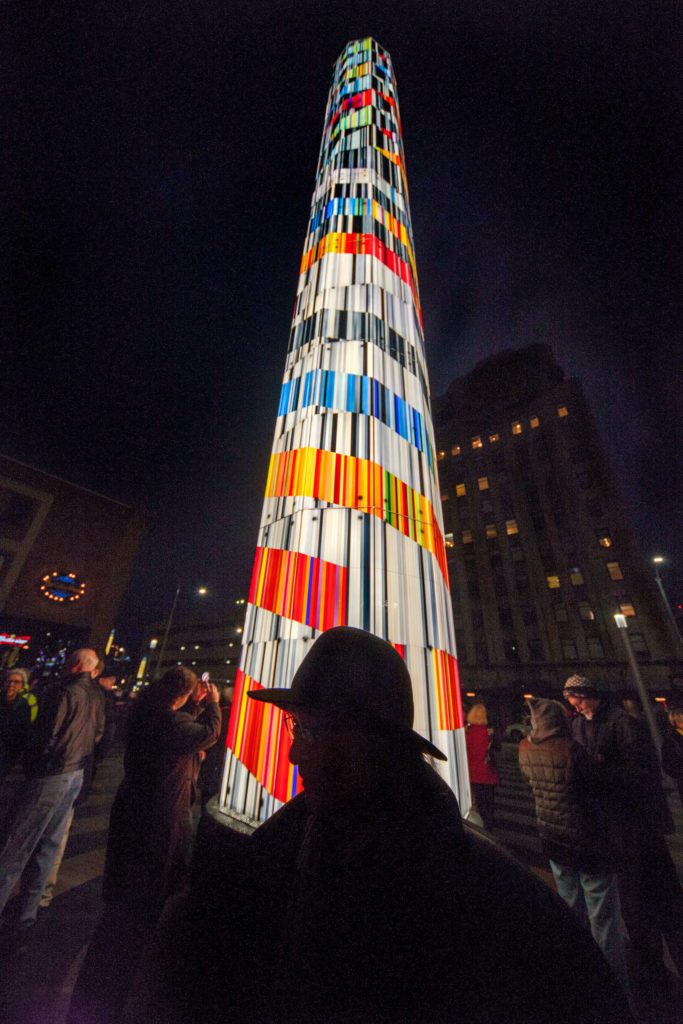
Photo: Takashi Hatakeyama.
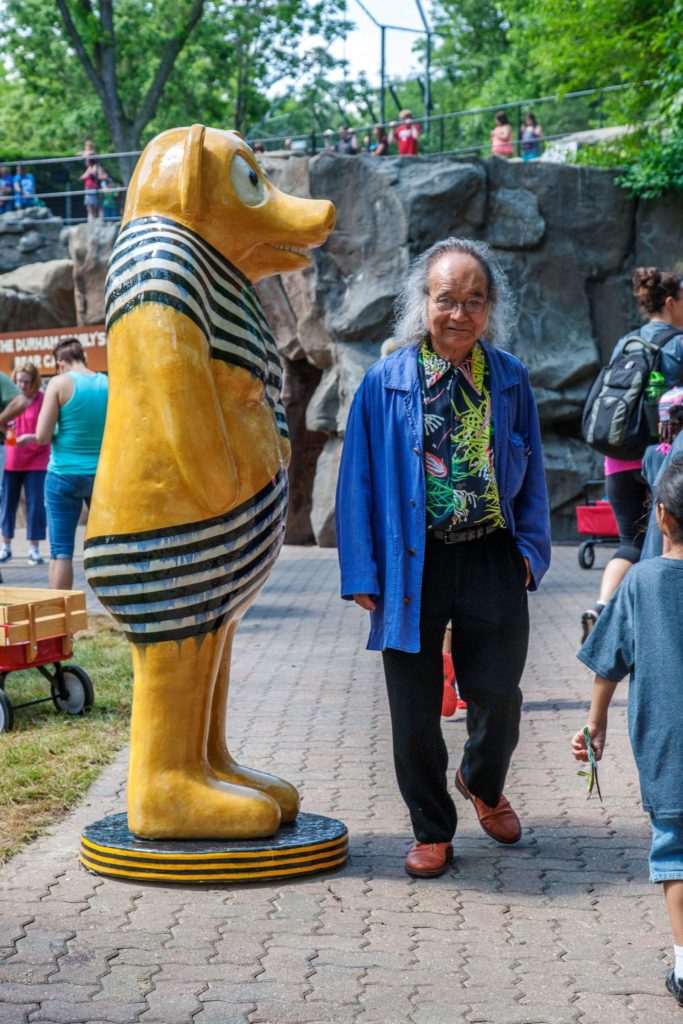
Photo: Takashi Hatakeyama.
2015
January. Kaneko works at Building Products Co. in Phoenix, where thirteen-foot-long test pipes come out of the kiln. The Kanekos travel to the raku studio and the Puerto Vallarta studio in Mexico.
February. The Kanekos return to Phoenix to continue working at Building Products Co.
March. Yoshiko Wada visits Jun Kaneko in Omaha and holds a workshop at KANEKO.
April. Fidelio rehearsals begin at Opera Omaha. The redesigned opera premiers on the 17th. Jack Lenor Larsen visits the studio and gives a lecture at KANEKO.
May. The Kanekos travel to Memphis, TN for the opening of Jun Kaneko at Dixon Gallery & Gardens. Fired columns arrive from Phoenix, as well as the latest raku Wall Slabs from Mexico.
Summer. Kaneko works in his Omaha studio, and on the design of his colonnades. He visits Misha Gordin. Leiko Ikemura and Phillip von Matt travel to Omaha to work at the studio. Mark Mack visits the Kanekos.
August – September. The Kanekos travel to Mexico. Jun begins work on his new raku series, perfecting the casting of Heads and developing new glazes. San Francisco Opera’s The Magic Flute rehearsals begin. Glen Brown, professor of Art History at Kansas State University, interviews Kaneko.
October. The Kanekos travel to San Francisco to attend technical rehearsals at the opera. Jun works at Artworks Foundry on a series of large scale bronze heads. The Omaha Sister City delegation travels to Shizuoka, Japan. They present one of Kaneko’s Tanukis to the City Zoo as a gift. Dale Chihuly visits the Omaha Studio and KANEKO.
November. The Kanekos return to Phoenix to continue work on Jun’s columns at Building Products Co., and for the International Sculpture Center conference. Takashi Hatakeyama meets them there. The Dixon Gallery & Gardens exhibition closes.
December. The Kanekos return to Omaha. Jun works on a series of smaller works for his spring show in Japan. Eleven-foot-tall Dangos and ten-foot-tall Heads are bisque fired at the S. 20th St. studio.
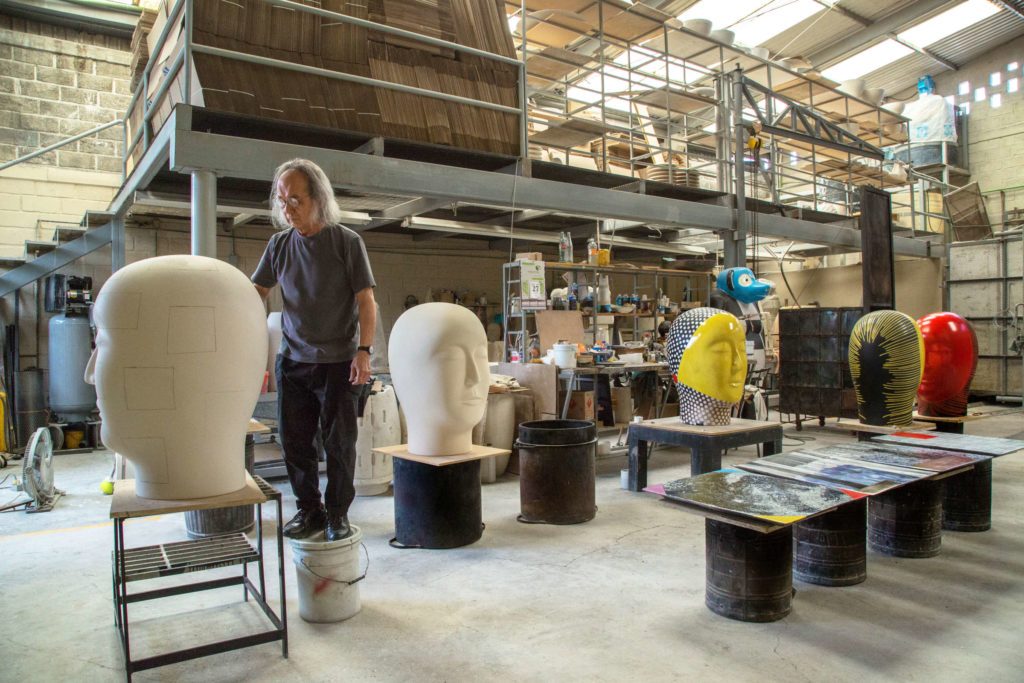
Photo: Takashi Hatakeyama.
2016
January. Kaneko continues his work on his new constructions and refines his design concept for the Fred and Pamela Buffett Cancer Center. Joel Geyer conducts a series of interviews for a PBS documentary about Jun.
February. The Kanekos travel to Mexico to work at the raku studio. Takashi Hatakeyama meets them in Mexico then travels to Phoenix to photograph the Columns. The Kanekos travel to New York for the International Sculpture Center Annual Gala.
March. Solo exhibitions open at Sherry Leedy Gallery (Kansas City), Locks Gallery, (Philadelphia), and Austin Art Projects, (Palm Desert, CA).
April. The Kanekos return from Japan. An exhibition at LongHouse Reserve in East Hampton, NY opens.
May. Mr. Kasahara visits Kaneko’s studio in Omaha. The Kanekos travel to Germany with Susan Schonlau to meet with the team at Derix Glass Studios in Taunusstein. There, Jun unveils the final proposal for Search, an eighty-two foot glass tower to be erected at the Fred and Pamela Buffett Cancer Center, Omaha, NE.
July. Barbara Derix and her assistant visit Omaha to attend an installation coordination meeting for Search at the UNMC Cancer Center. A solo exhibition opens at Gerald Peters Gallery in Santa Fe.
September. The Kanekos travel to Los Angeles where Jun speaks at the UCLA symposium, The Architecture of Performance. While in Los Angeles, they attend the opening of Jun Kaneko: Mirage at the Edward Cella Gallery. Afterwards, they return to Mexico to work at the raku studio. Jun makes a series of raku slabs and raku heads. Some of the heads in this series are covered in glass tile mosaics.
October. The Kanekos return from Mexico. A solo exhibition at the Cedarhurst Center for the Arts in Mount Vernon, IL opens. The Duncan columns are installed.
November. Madama Butterfly opens at the San Francisco Opera House and runs for ten performances. The group exhibition, Passion and Obsession: From the Collection, featuring work by Jun as well as work from the Kanekos’ private collection, opens at KANEKO.
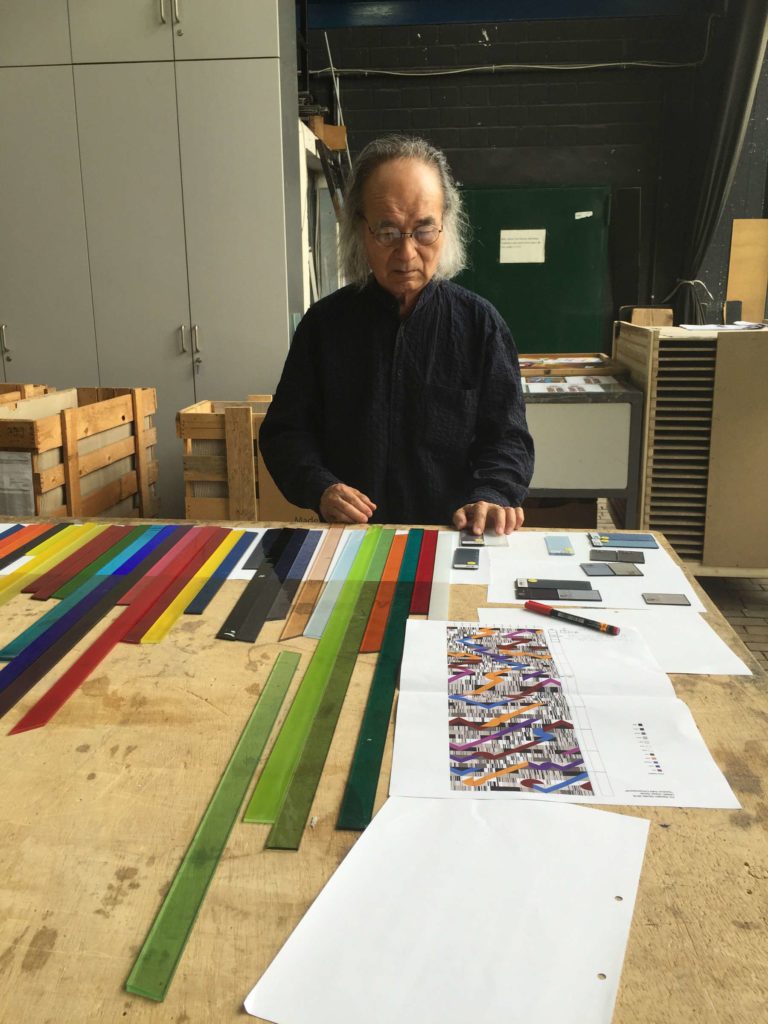
Photo: Jun Kaneko Studio.
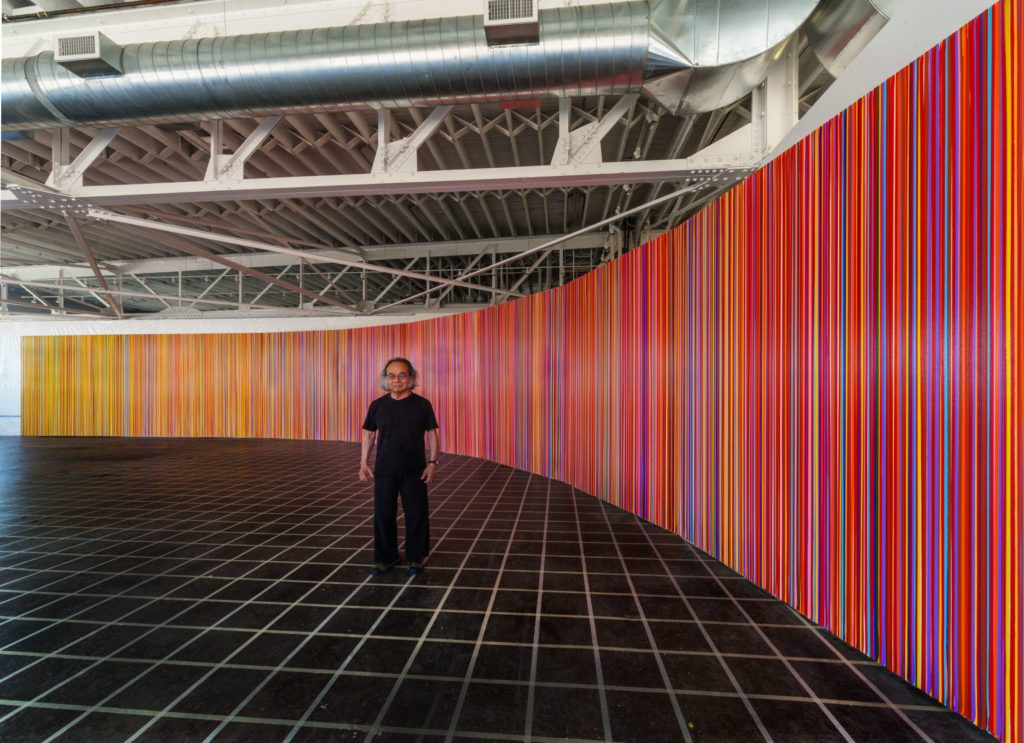
Photo: Takashi Hatakeyama.
2017
January. The first in a new series of dangos and slabs come out of the kiln in Omaha. This series features a type of glaze that Kaneko first worked with at EKWC in 1995.
February. The Kanekos head to Puerto Vallarta and Cuernavaca to work at the raku studio, and Mexico City to visit the Palacio de Belles Artes. At the raku studio, Jun works on a series of dangos, heads, and wall cylinders.
March. Kaneko’s nine-panel acrylic painting, Mirage, is featured in the Platform Series at the Armory Show in New York City. The Kanekos return from Mexico City.
April. A solo exhibition opens at the Kennedy Center in Washington DC. The installation of Search begins at the Fed and Pamela Buffett Cancer Center at UNMC. Takashi Hatakeyama arrives in Omaha to visit the Kanekos and goes to Washington DC with them in the following month.
May. The Kanekos travel to Washington DC for the final rehearsal week and the premier of Madama Butterfly. It opens May 6th at the Washington National Opera and runs for fourteen performances. Search installation is completed. Takashi Hatakeyama returns to Japan.
June. Two dangos are installed at Railside Plaza in Grand Island, NE. Alice Corning, Juan Sanchez, and Karl Heinz Traut visit Omaha. There is a dedication and lighting ceremony for the Search tower.
July. KANEKO begins its capital campaign to construct the Collection Building to house Kaneko’s collection and archives. The campaign is launched on Jun’s 75th birthday, at which Mark Mack speaks about the building design.
September. A pair of Heads are installed flanking the entrance of Toronto’s Bisha Hotel and Residencies. Three of Kaneko’s 13-foot-tall Columns were installed at the Yanney Heritage Park in Kearney, NE.
October. An exhibition of Kaneko’s sculptures is installed at the Desert Botanical Gardens in Phoenix. A group exhibition Emphasized: An Eye on Scale featuring two head sculptures opens at the Hawaii State Art Museum.
November. Capturing the Scent of Rain, an exhibition of Kaneko’s new series of sculptures, opens at the David and Gladys Wright House in Phoenix, AZ. Kaneko receives the 2018 American Craft Council (ACC) Gold Medal for Consummate Craftsmanship from the American Craft Council. The Award Ceremony is held at KANEKO. Takashi Hatakeyama photographs in Phoenix and stays in Omaha for the ACC award. Mr. Kasahara comes to Omaha for ACC award. Terry and Jo Harvey Allen visit Omaha.
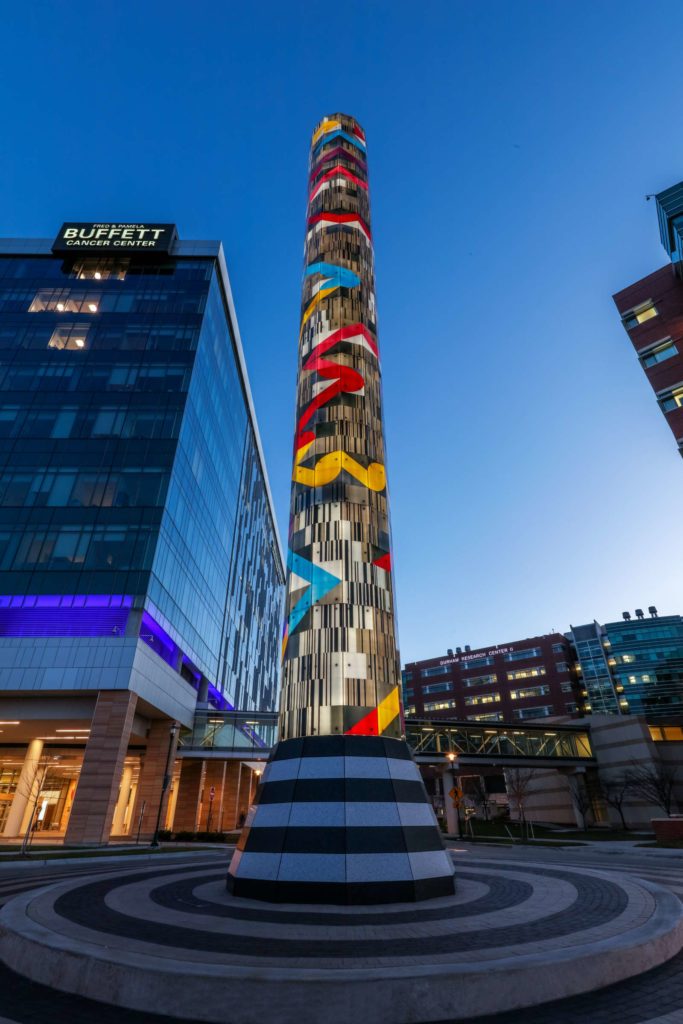
Photo: Takashi Hatakeyama.
2018
January. Juan Sanchez spends a week in Omaha.
March. Blurred Lines, an exhibition curated by former Bemis resident and director, Mark Masuoka, opens at the Akron Art Museum in Ohio.
Bullseye Wall is installed at the Portland Japanese Gardens in Portland, Oregon.
April-November: Six additional solo exhibitions of Kaneko’s work open across the United States and in Osaka.
May. Ryunosuke and Toshiko Kasahara visit Kaneko in Omaha. Representatives from Hungary’s University of Pécs travel to Omaha to present Kaneko with an Honorary Doctorate from their institution. The event was held at the Kanekos’ private loft and was photographed by Takashi Hatakeyama.
August. University of Nebraska Medical Center approves the purchase of nine of Kaneko’s Columns. Installation planning begins.
2019
June. Origin Columns installation is completed at University of Nebraska Medical Center campus in Omaha.
August. Two solo exhibitions of Kaneko’s work open in the United States.
September. Opera Omaha performs Kaneko’s Madama Butterfly at the Orpheum theater in Omaha. A dedication ceremony is held for the UNMC Plaza, where Origin is installed.
December. Jun and Ree Kaneko travel to Juan Sanchez’s studio in Cuernavaca, Mexico for a Raku work session. In Omaha, building begins on a set of six 9-foot triangles and three 11-foot triangles- the largest dangos of this shape Kaneko has made to date.
2020
February. Jun and Ree Kaneko return to Omaha from a Raku work session in Cuernavaca.
March. Building of 9- and 11-foot triangles is completed.
June. The Space Between: Frank Lloyd Wright | Jun Kaneko is installed at the Martin House in Buffalo, NY.
Present. Jun Kaneko continues his work at his Omaha studio.